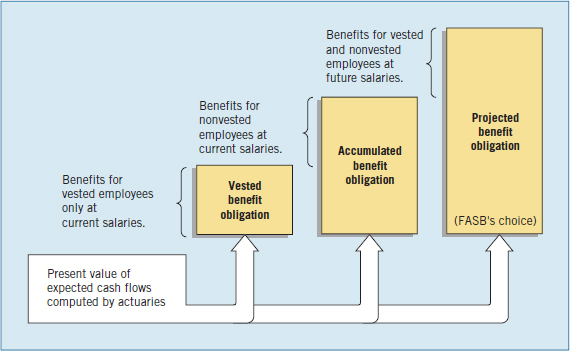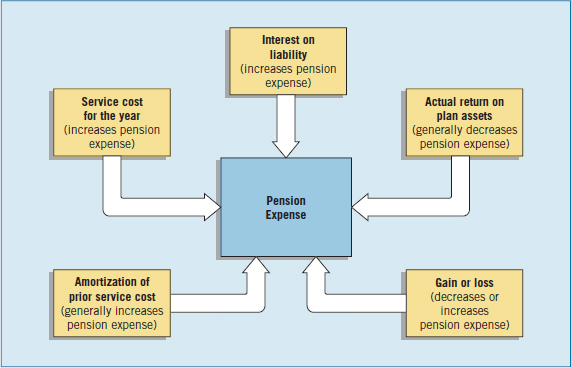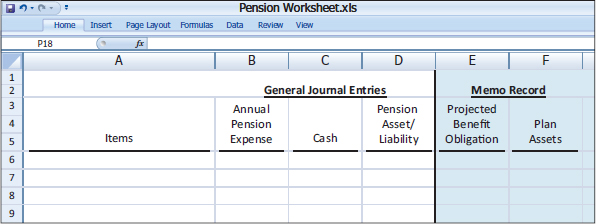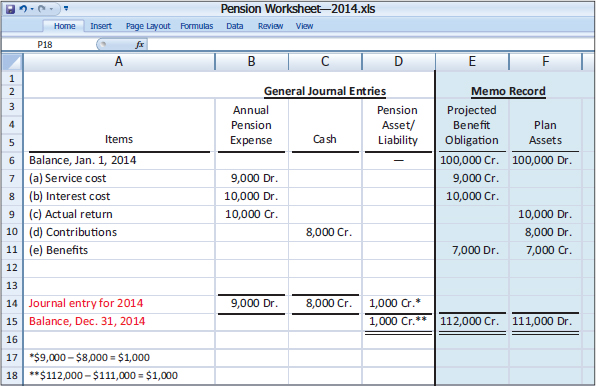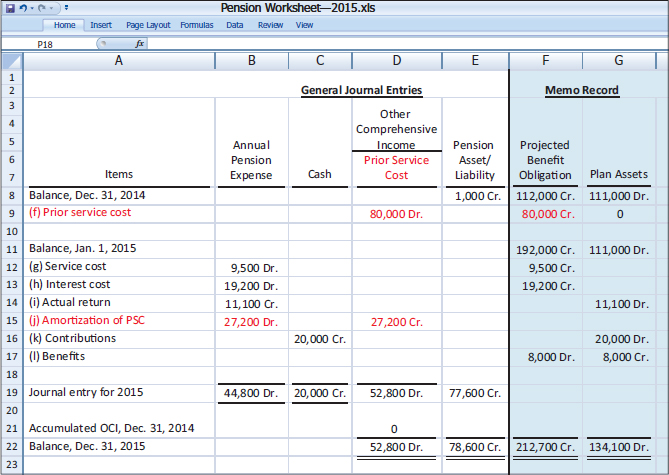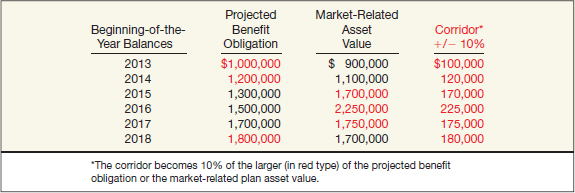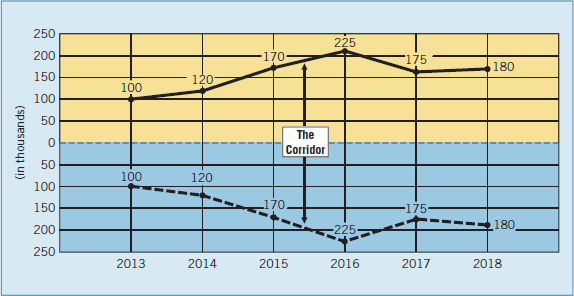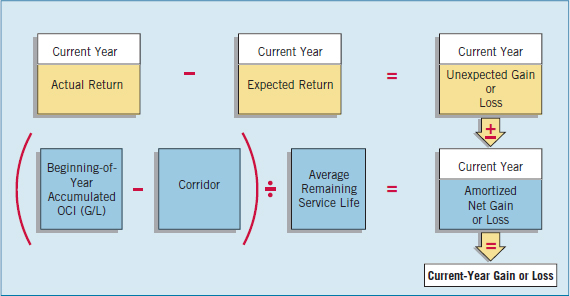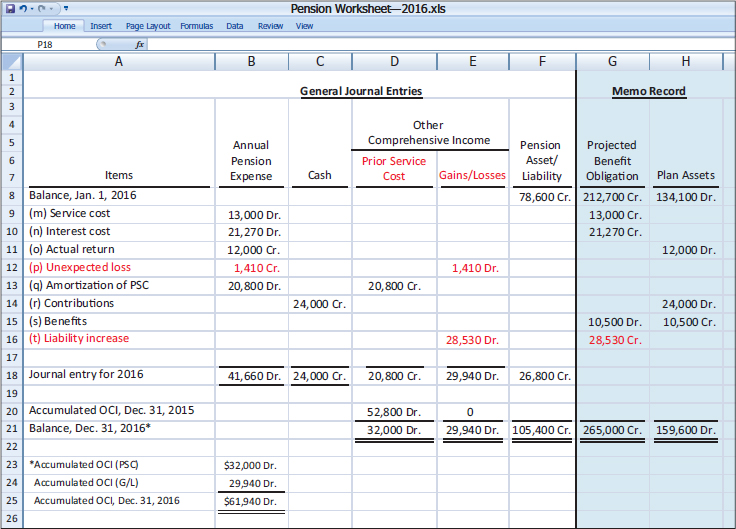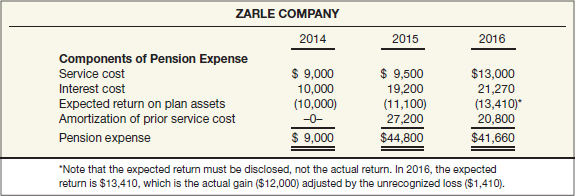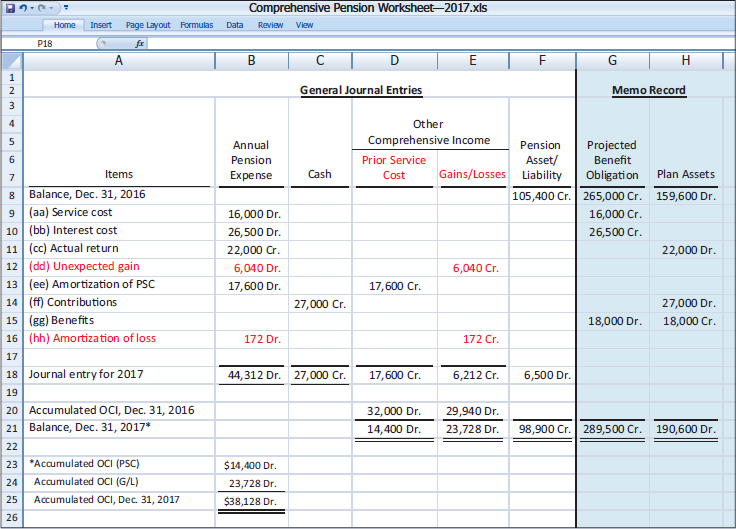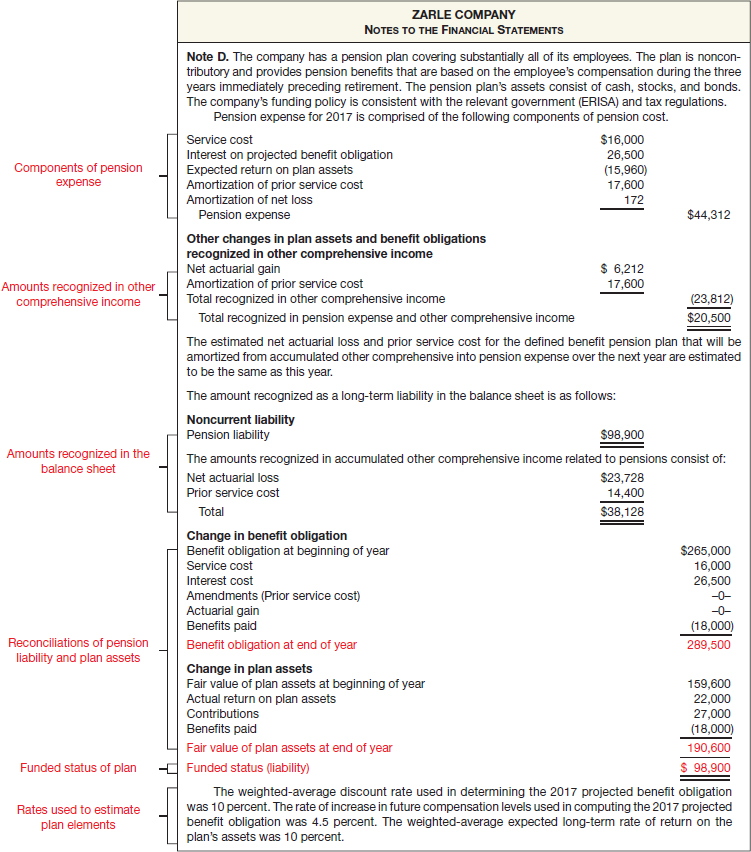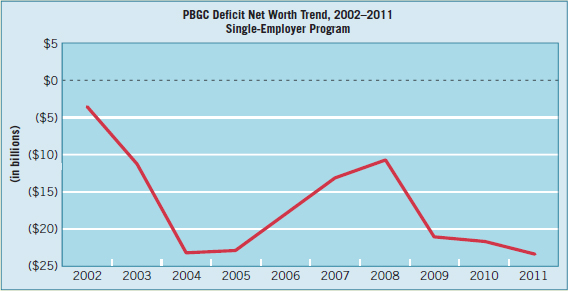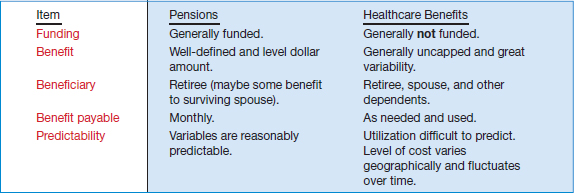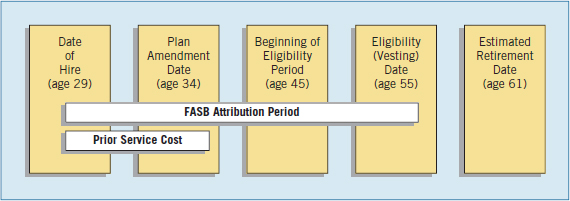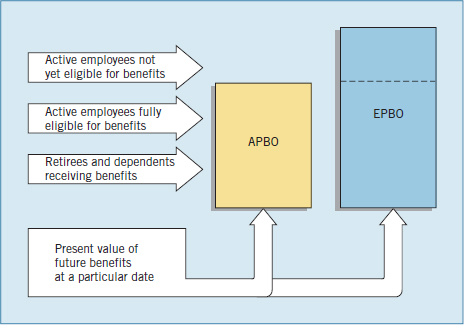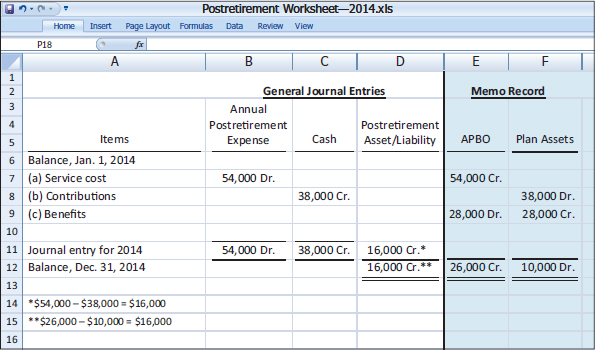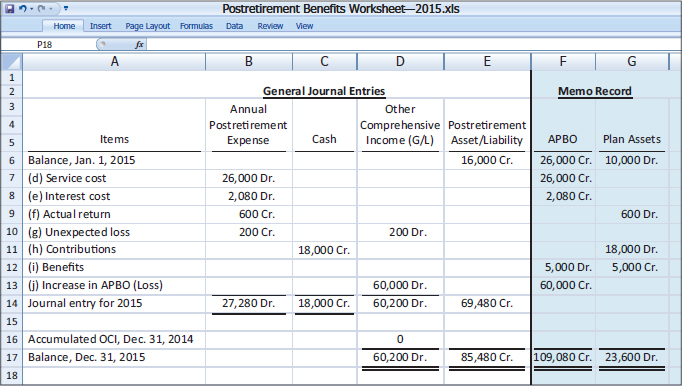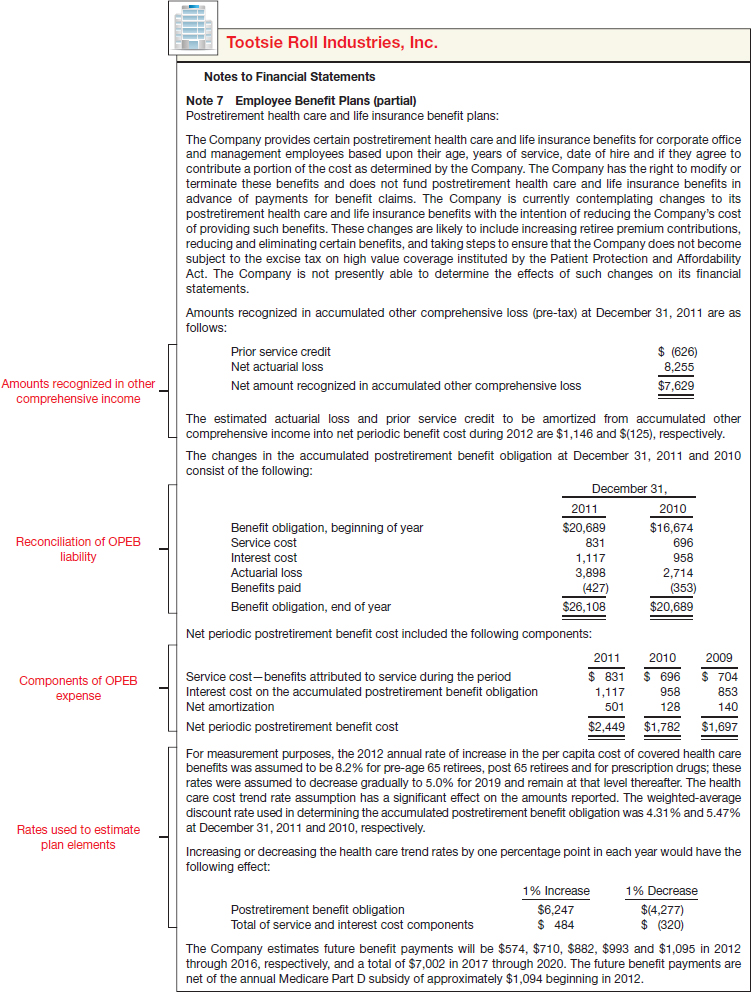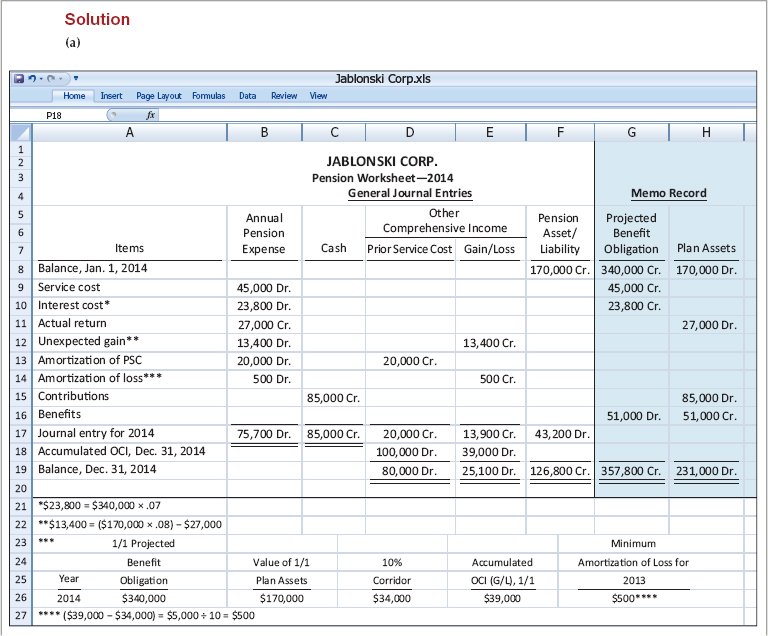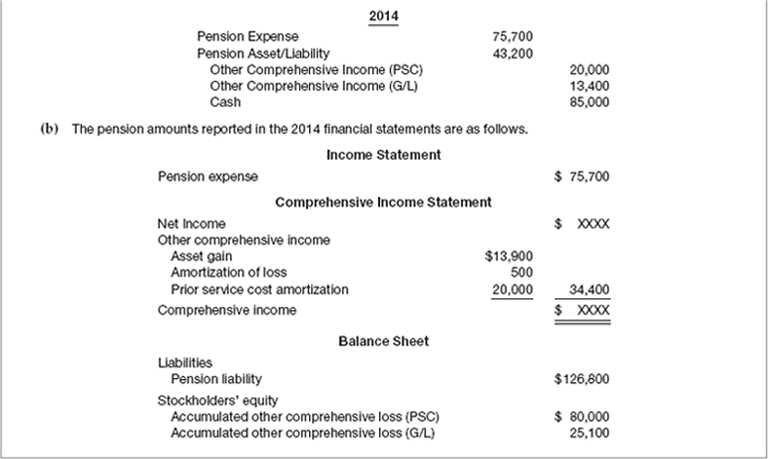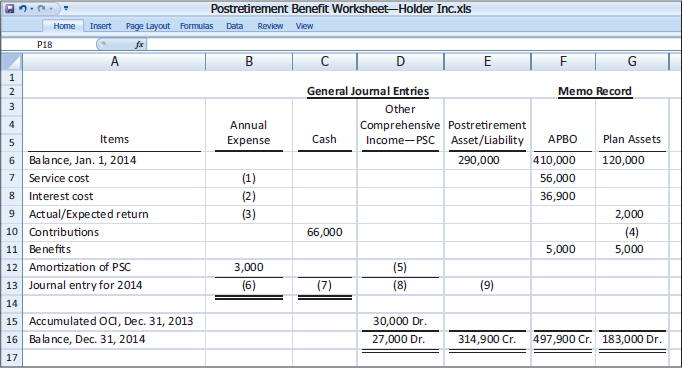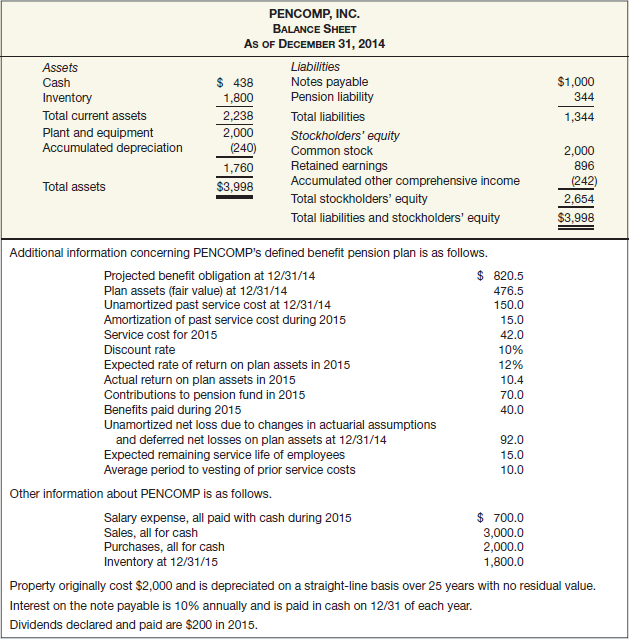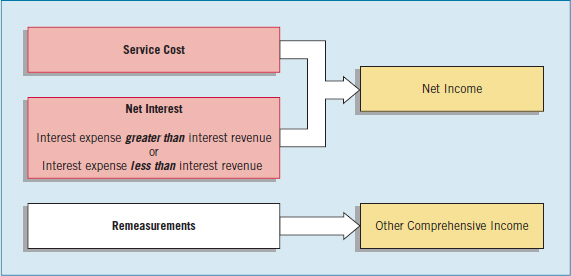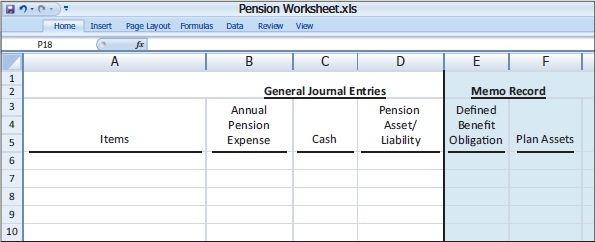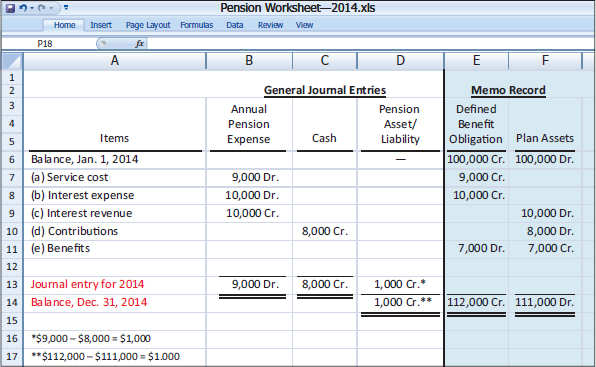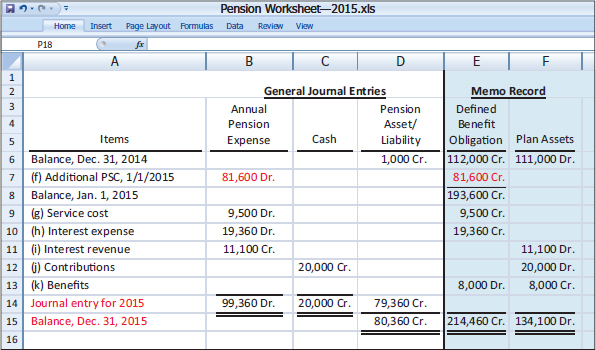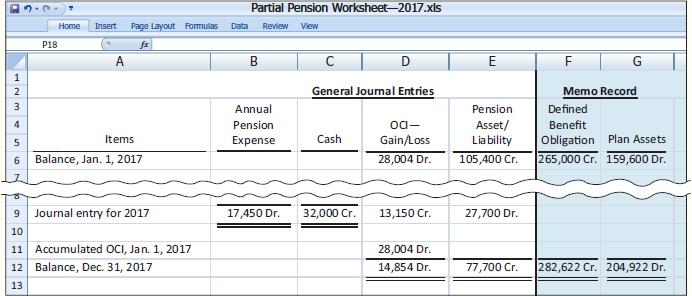CHAPTER 20 Accounting for Pensions and Postretirement Benefits
LEARNING OBJECTIVES
After studying this chapter, you should be able to:
- Distinguish between accounting for the employer's pension plan and accounting for the pension fund.
- Identify types of pension plans and their characteristics.
- Explain alternative measures for valuing the pension obligation.
- List the components of pension expense.
- Use a worksheet for employer's pension plan entries.
- Describe the amortization of prior service costs.
- Explain the accounting for unexpected gains and losses.
- Explain the corridor approach to amortizing gains and losses.
- Describe the requirements for reporting pension plans in financial statements.
Where Have All the Pensions Gone?
Many companies have benefit plans that promise income and other benefits to retired employees in exchange for services during their working years. However, a shift is on from traditional defined benefit plans, in which employers bear the risk of meeting the benefit promises, to plans in which employees bear more of the risk. In some cases, employers are dropping retirement plans altogether. Here are some of the reasons for the shift.
- Competition. Newer and foreign competitors do not have the same retiree costs that older U.S. companies do. Southwest Airlines does not offer a traditional pension plan, but United has a pension deficit exceeding $100,000 per employee.
- Cost. Retirees are living longer, and the costs of retirement are higher. Combined with annual retiree healthcare costs, retirement benefits are costing the S&P 500 companies over $25 billion a year and are rising at double-digit rates.
- Insurance. Pensions are backed by premiums paid to the Pension Benefit Guarantee Corporation (PBGC). When a company fails, the PBGC takes over the plan. But due to a number of significant company failures, the PBGC is running a deficit, and healthy companies are subsidizing the weak.
- Accounting. To bring U.S. standards in line with international rules, accounting rule-makers are considering rules that will require companies to “mark their pensions to market” (value them at market rates). Such a move would increase the reported volatility of the retirement plan and of company financial statements. When Great Britain made this shift, 25 percent of British companies closed their plans to new entrants.

As a result of such factors, it is understandable that experts can think of no major company that has instituted a traditional pension plan in the past decade. What does this mean for you as you evaluate job offers and benefit packages? To start, you should begin building your own retirement nest egg, rather than relying on your employer to provide postretirement income and healthcare benefits. Recently, a sample of Americans was asked the following question: When you retire, do you think you will have enough money to live comfortably, or not? The graph on the previous page shows a substantial change in responses from nonretired adults from 2002 to 2011.
![]() CONCEPTUAL FOCUS
CONCEPTUAL FOCUS
- See the Underlying Concepts on pages 1189, 1208, 1209, and 1213.
- Read the Evolving Issue on page 1202 for a discussion of the corridor approach.
![]() INTERNATIONAL FOCUS
INTERNATIONAL FOCUS
- See the International Perspectives on pages 1186 and 1207.
- Read the IFRS Insights on pages 1250–1266 for a discussion of:
- Accounting for pensions
- Using a pension worksheet
In 2002, adults were nearly twice as likely to say they would have enough money to live comfortably (59%) as to say they would not (32%). Those views changed as time passed. By 2011, a majority said they would not have enough money to live comfortably in retirement.
General economic conditions affect how Americans look at retirement. Americans were more positive about the overall economy—and retirement—prior to the recent recession than they are now. The continuing political discussion about the fragility of the country's Social Security and Medicare programs may also reduce nonretired Americans' comfort with projections of their monetary resources in their retirement. In addition, many are beginning to realize that retirement at the age of 65 may no longer be possible given the possible extension of social benefits to later ages.
This means that retirement accounts, including individual retirement accounts and defined contribution pensions such as 401(k) plans, will need to become a bigger piece of the pie to fill the gap left by smaller government and employer-sponsored benefits. So get started now with a personal savings strategy to ensure an adequate nest egg at your retirement.
Sources: Story adapted from Nanette Byrnes with David Welch, “The Benefits Trap,” BusinessWeek (July 19, 2004), pp. 54–72; and F. Newport, “In U.S., 53% Worry About Having Enough Money in Retirement,” http://www.gallup.com/poll/147254/%20-americans-biggest-financial-worry.aspx (April 25, 2011).
PREVIEW OF CHAPTER 20
As our opening story indicates, the cost of retirement benefits is steep. For example, British Airways' pension and healthcare costs for retirees in a recent year totaled $195 million, or approximately $6 per passenger carried. Many other companies are also facing substantial pension and other postretirement expenses and obligations. In this chapter, we discuss the accounting issues related to these benefit plans. The content and organization of the chapter are as follows.
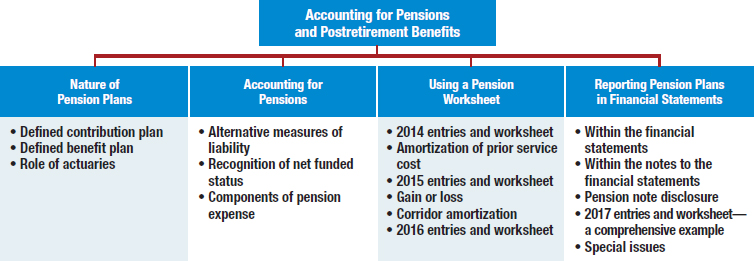
NATURE OF PENSION PLANS
LEARNING OBJECTIVE ![]()
Distinguish between accounting for the employer's pension plan and accounting for the pension fund.
A pension plan is an arrangement whereby an employer provides benefits (payments) to retired employees for services they provided in their working years. Pension accounting may be divided and separately treated as accounting for the employer and accounting for the pension fund. The company or employer is the organization sponsoring the pension plan. It incurs the cost and makes contributions to the pension fund. The fund or plan is the entity that receives the contributions from the employer, administers the pension assets, and makes the benefit payments to the retired employees (pension recipients). Illustration 20-1 shows the three entities involved in a pension plan and indicates the flow of cash among them.
A pension plan is funded when the employer makes payments to a funding agency.1 That agency accumulates the assets of the pension fund and makes payments to the recipients as the benefits come due.
Some pension plans are contributory. In these, the employees bear part of the cost of the stated benefits or voluntarily make payments to increase their benefits. Other plans are noncontributory. In these plans, the employer bears the entire cost. Companies generally design their pension plans so as to take advantage of federal income tax benefits. Plans that offer tax benefits are called qualified pension plans. They permit deductibility of the employer's contributions to the pension fund and tax-free status of earnings from pension fund assets.
The pension fund should be a separate legal and accounting entity. The pension fund, as a separate entity, maintains a set of books and prepares financial statements. Maintaining records and preparing financial statements for the fund, an activity known as “accounting for employee benefit plans,” is not the subject of this chapter.2 Instead, this chapter explains the pension accounting and reporting problems of the employer as the sponsor of a pension plan.
The need to properly administer and account for pension funds becomes apparent when you understand the size of these funds. Listed in Illustration 20-2 are the pension fund assets and pension expenses of six major companies.
![]() See the FASB Codification section (page 1229).
See the FASB Codification section (page 1229).
As Illustration 20-2 indicates, pension expense is a substantial percentage of total pretax income for many companies.3 The two most common types of pension plans are defined contribution plans and defined benefit plans, and we look at each of them in the following sections.
Defined Contribution Plan
LEARNING OBJECTIVE ![]()
Identify types of pension plans and their characteristics.
In a defined contribution plan, the employer agrees to contribute to a pension trust a certain sum each period, based on a formula. This formula may consider such factors as age, length of employee service, employer's profits, and compensation level. The plan defines only the employer's contribution. It makes no promise regarding the ultimate benefits paid out to the employees. A common form of this plan is a 401(k) plan.
The size of the pension benefits that the employee finally collects under the plan depends on several factors: the amounts originally contributed to the pension trust, the income accumulated in the trust, and the treatment of forfeitures of funds caused by early terminations of other employees. A company usually turns over to an independent third-party trustee the amounts originally contributed. The trustee, acting on behalf of the beneficiaries (the participating employees), assumes ownership of the pension assets and is accountable for their investment and distribution. The trust is separate and distinct from the employer.
The accounting for a defined contribution plan is straightforward. The employee gets the benefit of gain (or the risk of loss) from the assets contributed to the pension plan. The employer simply contributes each year based on the formula established in the plan. As a result, the employer's annual cost (pension expense) is simply the amount that it is obligated to contribute to the pension trust. The employer reports a liability on its balance sheet only if it does not make the contribution in full. The employer reports an asset only if it contributes more than the required amount.
In addition to pension expense, the employer must disclose the following for a defined contribution plan: a plan description, including employee groups covered; the basis for determining contributions; and the nature and effect of significant matters affecting comparability from period to period.[2]
Defined Benefit Plan
A defined benefit plan outlines the benefits that employees will receive when they retire. These benefits typically are a function of an employee's years of service and of the compensation level in the years approaching retirement.
To meet the defined benefit commitments that will arise at retirement, a company must determine what the contribution should be today (a time value of money computation). Companies may use many different contribution approaches. However, the funding method should provide enough money at retirement to meet the benefits defined by the plan.
The employees are the beneficiaries of a defined contribution trust, but the employer is the beneficiary of a defined benefit trust. Under a defined benefit plan, the trust's primary purpose is to safeguard and invest assets so that there will be enough to pay the employer's obligation to the employees. In form, the trust is a separate entity. In substance, the trust assets and liabilities belong to the employer. That is, as long as the plan continues, the employer is responsible for the payment of the defined benefits (without regard to what happens in the trust). The employer must make up any shortfall in the accumulated assets held by the trust. On the other hand, the employer can recapture any excess accumulated in the trust, either through reduced future funding or through a reversion of funds.
![]() International Perspective
International Perspective
Outside the United States, private pension plans are less common because many other nations rely on government-sponsored pension plans. Consequently, accounting for defined benefit pension plans is typically a less important issue elsewhere in the world.
Because a defined benefit plan specifies benefits in terms of uncertain future variables, a company must establish an appropriate funding pattern to ensure the availability of funds at retirement in order to provide the benefits promised. This funding level depends on a number of factors such as turnover, mortality, length of employee service, compensation levels, and interest earnings.
Employers are at risk with defined benefit plans because they must contribute enough to meet the cost of benefits that the plan defines. The expense recognized each period is not necessarily equal to the cash contribution. Similarly, the liability is controversial because its measurement and recognition relate to unknown future variables. Thus, the accounting issues related to this type of plan are complex. Our discussion in the following sections deals primarily with defined benefit plans.4
What do the numbers mean? WHICH PLAN IS RIGHT FOR YOU?
Defined contribution plans have become much more popular with employers than defined benefit plans, as indicated in the chart below. One reason is that they are cheaper. Defined contribution plans often cost no more than 3 percent of payroll, whereas defined benefit plans can cost 5 to 6 percent of payroll.
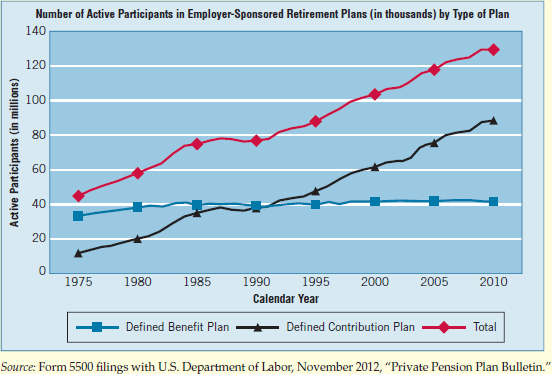
The total amount of assets held by pension plans increased 14 percent to $6.3 trillion in 2010. Defined benefit plan assets increased 12 percent to $2.4 trillion, while defined contribution plans increased 16 percent to $3.8 trillion.
The Role of Actuaries in Pension Accounting
The problems associated with pension plans involve complicated mathematical considerations. Therefore, companies engage actuaries to ensure that a pension plan is appropriate for the employee group covered.5 Actuaries are individuals trained through a long and rigorous certification program to assign probabilities to future events and their financial effects. The insurance industry employs actuaries to assess risks and to advise on the setting of premiums and other aspects of insurance policies. Employers rely heavily on actuaries for assistance in developing, implementing, and funding pension funds.
Actuaries make predictions (called actuarial assumptions) of mortality rates, employee turnover, interest and earnings rates, early retirement frequency, future salaries, and any other factors necessary to operate a pension plan. They also compute the various pension measures that affect the financial statements, such as the pension obligation, the annual cost of servicing the plan, and the cost of amendments to the plan. In summary, accounting for defined benefit pension plans relies heavily upon information and measurements provided by actuaries.
ACCOUNTING FOR PENSIONS
LEARNING OBJECTIVE ![]()
Explain alternative measures for valuing the pension obligation.
In accounting for a company's pension plan, two questions arise. (1) What is the pension obligation that a company should report in the financial statements? (2) What is the pension expense for the period? Attempting to answer the first question has produced much controversy.
Alternative Measures of the Liability
Most agree that an employer's pension obligation is the deferred compensation obligation it has to its employees for their service under the terms of the pension plan. Measuring that obligation is not so simple, though, because there are alternative ways of measuring it.6
One measure of the pension obligation is to base it only on the benefits vested to the employees. Vested benefits are those that the employee is entitled to receive even if he or she renders no additional services to the company. Most pension plans require a certain minimum number of years of service to the employer before an employee achieves vested benefits status. Companies compute the vested benefit obligation using only vested benefits, at current salary levels.
Another way to measure the obligation uses both vested and nonvested years of service. On this basis, the company computes the deferred compensation amount on all years of employees' service—both vested and nonvested—using current salary levels. This measurement of the pension obligation is called the accumulated benefit obligation.
A third measure bases the deferred compensation amount on both vested and nonvested service using future salaries. This measurement of the pension obligation is called the projected benefit obligation. Because future salaries are expected to be higher than current salaries, this approach results in the largest measurement of the pension obligation.
The choice between these measures is critical. The choice affects the amount of a company's pension liability and the annual pension expense reported. The diagram in Illustration 20-3 presents the differences in these three measurements.
Which of these alternative measures of the pension liability does the profession favor? The profession adopted the projected benefit obligation—the present value of vested and nonvested benefits accrued to date, based on employees' future salary levels.7 Those in favor of the projected benefit obligation contend that a promise by an employer to pay benefits based on a percentage of the employees' future salaries is far greater than a promise to pay a percentage of their current salary, and such a difference should be reflected in the pension liability and pension expense.
Moreover, companies discount to present value the estimated future benefits to be paid. Minor changes in the interest rate used to discount pension benefits can dramatically affect the measurement of the employer's obligation. For example, a 1 percent decrease in the discount rate can increase pension liabilities 15 percent. Accounting rules require that at each measurement date, a company must determine the appropriate discount rate used to measure the pension liability, based on current interest rates.
Recognition of the Net Funded Status of the Pension Plan
Companies must recognize on their balance sheet the full overfunded or underfunded status of their defined benefit pension plan.8[3] The overfunded or underfunded status is measured as the difference between the fair value of the plan assets and the projected benefit obligation.
To illustrate, assume that Coker Company has a projected benefit obligation of $300,000, and the fair value of its plan assets is $210,000. In this case, Coker Company's pension plan is underfunded, and therefore it reports a pension liability of $90,000 ($300,000 − $210,000) on its balance sheet. If instead the fair value of Coker's plan assets were $430,000, it would report a pension asset of $130,000 ($430,000 − $300,000).
In 2007, by slowing the growth of pension liabilities and increasing contributions to pension funds, the S&P 500 companies reported aggregate overfunding (assets exceeded liabilities) of $47.2 billion. However, by 2011, these same pension plans were underfunded by $358.4 billion.9
Components of Pension Expense
LEARNING OBJECTIVE ![]()
List the components of pension expense.
There is broad agreement that companies should account for pension cost on the accrual basis.10 The profession recognizes that accounting for pension plans requires measurement of the cost and its identification with the appropriate time periods. The determination of pension cost, however, is extremely complicated because it is a function of the following components.
![]() Underlying Concepts
Underlying Concepts
The expense recognition principle and the definition of a liability justify accounting for pension cost on the accrual basis. This requires recording an expense when employees earn the future benefits, and recognizing an existing obligation to pay pensions later based on current services received.
- Service cost. Service cost is the expense caused by the increase in pension benefits payable (the projected benefit obligation) to employees because of their services rendered during the current year. Actuaries compute service cost as the present value of the new benefits earned by employees during the year.
- Interest on the liability. Because a pension is a deferred compensation arrangement, there is a time value of money factor. As a result, companies record the pension liability on a discounted basis. Interest expense accrues each year on the projected benefit obligation just as it does on any discounted debt. The actuary helps to select the interest rate, referred to as the settlement rate.
- Actual return on plan assets. The return earned by the accumulated pension fund assets in a particular year is relevant in measuring the net cost to the employer of sponsoring an employee pension plan. Therefore, a company should adjust annual pension expense for interest and dividends that accumulate within the fund, as well as increases and decreases in the fair value of the fund assets.
- Amortization of prior service cost. Pension plan amendments (including initiation of a pension plan) often include provisions to increase benefits (or in rare situations, to decrease benefits) for employee service provided in prior years. A company grants plan amendments with the expectation that it will realize economic benefits in future periods. Thus, it allocates the cost (prior service cost) of providing these retroactive benefits to pension expense in the future, specifically to the remaining service-years of the affected employees.
- Gain or loss. Volatility in pension expense can result from sudden and large changes in the fair value of plan assets and by changes in the projected benefit obligation (which changes when actuaries modify assumptions or when actual experience differs from expected experience). Two items comprise this gain or loss: (1) the difference between the actual return and the expected return on plan assets, and (2) amortization of the net gain or loss from previous periods. We will discuss this complex computation later in the chapter.
Illustration 20-4 shows the components of pension expense and their effect on total pension expense (increase or decrease).
Service Cost
The service cost is the actuarial present value of benefits attributed by the pension benefit formula to employee service during the period. That is, the actuary predicts the additional benefits that an employer must pay under the plan's benefit formula as a result of the employees' current year's service, and then discounts the cost of those future benefits back to their present value.
The Board concluded that companies must consider future compensation levels in measuring the present obligation and periodic pension expense if the plan benefit formula incorporates them. In other words, the present obligation resulting from a promise to pay a benefit of 1 percent of an employee's final pay differs from the promise to pay 1 percent of current pay. To overlook this fact is to ignore an important aspect of pension expense. Thus, the FASB adopts the benefits/years-of-service actuarial method, which determines pension expense based on future salary levels.
Some object to this determination, arguing that a company should have more freedom to select an expense recognition pattern. Others believe that incorporating future salary increases into current pension expense is accounting for events that have not yet happened. They argue that if a company terminates the plan today, it pays only liabilities for accumulated benefits. Nevertheless, the FASB indicates that the projected benefit obligation provides a more realistic measure of the employer's obligation under the plan on a going concern basis and, therefore, companies should use it as the basis for determining service cost.
Interest on the Liability
The second component of pension expense is interest on the liability, or interest expense. Because a company defers paying the liability until maturity, the company records it on a discounted basis. The liability then accrues interest over the life of the employee. The interest component is the interest for the period on the projected benefit obligation outstanding during the period. The FASB did not address the question of how often to compound the interest cost. To simplify our illustrations and problem materials, we use a simple interest computation, applying it to the beginning-of-the-year balance of the projected benefit liability.
How do companies determine the interest rate to apply to the pension liability? The Board states that the assumed discount rate should reflect the rates at which companies can effectively settle pension benefits. In determining these settlement rates, companies should look to rates of return on high-quality fixed-income investments currently available, whose cash flows match the timing and amount of the expected benefit payments. The objective of selecting the assumed discount rates is to measure a single amount that, if invested in a portfolio of high-quality debt instruments, would provide the necessary future cash flows to pay the pension benefits when due.
Actual Return on Plan Assets
Pension plan assets are usually investments in stocks, bonds, other securities, and real estate that a company holds to earn a reasonable return, generally at minimum risk. Employer contributions and actual returns on pension plan assets increase pension plan assets. Benefits paid to retired employees decrease them. As we indicated, the actual return earned on these assets increases the fund balance and correspondingly reduces the employer's net cost of providing employees' pension benefits. That is, the higher the actual return on the pension plan assets, the less the employer has to contribute eventually and, therefore, the less pension expense that it needs to report.
The actual return on the plan assets is the increase in pension funds from interest, dividends, and realized and unrealized changes in the fair value of the plan assets. Companies compute the actual return by adjusting the change in the plan assets for the effects of contributions during the year and benefits paid out during the year. The equation in Illustration 20-5, or a variation thereof, can be used to compute the actual return.
Stated another way, the actual return on plan assets is the difference between the fair value of the plan assets at the beginning of the period and at the end of the period, adjusted for contributions and benefit payments. Illustration 20-6 uses the equation above to compute the actual return, using some assumed amounts.
If the actual return on the plan assets is positive (a gain) during the period, a company subtracts it when computing pension expense. If the actual return is negative (a loss) during the period, the company adds it when computing pension expense.11
USING A PENSION WORKSHEET
LEARNING OBJECTIVE ![]()
Use a worksheet for employer's pension plan entries.
We will now illustrate the basic computation of pension expense using the first three components: (1) service cost, (2) interest on the liability, and (3) actual return on plan assets. We discuss the other pension expense components (amortization of prior service cost, and gains and losses) in later sections.
Companies often use a worksheet to record pension-related information. As its name suggests, the worksheet is a working tool. A worksheet is not a permanent accounting record. It is neither a journal nor part of the general ledger. The worksheet is merely a device to make it easier to prepare entries and the financial statements.12 Illustration 20-7 shows the format of the pension worksheet.
The “General Journal Entries” columns of the worksheet (near the left side) determine the entries to record in the formal general ledger accounts. The “Memo Record” columns (on the right side) maintain balances in the projected benefit obligation and the plan assets. The difference between the projected benefit obligation and the fair value of the plan assets is the pension asset/liability, which is shown in the balance sheet. If the projected benefit obligation is greater than the plan assets, a pension liability occurs. If the projected benefit obligation is less than the plan assets, a pension asset occurs.
On the first line of the worksheet, a company records the beginning balances (if any). It then records subsequent transactions and events related to the pension plan using debits and credits, using both sets of columns as if they were one. For each transaction or event, the debits must equal the credits. The ending balance in the Pension Asset/Liability column should equal the net balance in the memo record.
2014 Entries and Worksheet
To illustrate the use of a worksheet and how it helps in accounting for a pension plan, assume that on January 1, 2014, Zarle Company provides the following information related to its pension plan for the year 2014.
Plan assets, January 1, 2014, are $100,000.
Projected benefit obligation, January 1, 2014, is $100,000.
Annual service cost is $9,000.
Settlement rate is 10 percent.
Actual return on plan assets is $10,000.
Funding contributions are $8,000.
Benefits paid to retirees during the year are $7,000.
Using this data, the worksheet in Illustration 20-8 presents the beginning balances and all of the pension entries recorded by Zarle in 2014. Zarle records the beginning balances for the projected benefit obligation and the pension plan assets on the first line of the worksheet in the memo record. Because the projected benefit obligation and the plan assets are the same at January 1, 2014, the Pension Asset/Liability account has a zero balance at January 1, 2014.
Entry (a) in Illustration 20-8 records the service cost component, which increases pension expense by $9,000 and increases the liability (projected benefit obligation) by $9,000. Entry (b) accrues the interest expense component, which increases both the liability and the pension expense by $10,000 (the beginning projected benefit obligation multiplied by the settlement rate of 10 percent). Entry (c) records the actual return on the plan assets, which increases the plan assets and decreases the pension expense. Entry (d) records Zarle's contribution (funding) of assets to the pension fund, thereby decreasing cash by $8,000 and increasing plan assets by $8,000. Entry (e) records the benefit payments made to retirees, which results in equal $7,000 decreases to the plan assets and the projected benefit obligation.
Zarle makes the “formal journal entry” on December 31, which records the pension expense in 2014, as follows.

The credit to Pension Asset/Liability for $1,000 represents the difference between the 2014 pension expense of $9,000 and the amount funded of $8,000. Pension Asset/Liability (credit) is a liability because Zarle underfunds the plan by $1,000. The Pension Asset/Liability account balance of $1,000 also equals the net of the balances in the memo accounts. Illustration 20-9 shows that the projected benefit obligation exceeds the plan assets by $1,000, which reconciles to the pension liability reported in the balance sheet.
If the net of the memo record balances is a credit, the reconciling amount in the pension asset/liability column will be a credit equal in amount. If the net of the memo record balances is a debit, the pension asset/liability amount will be a debit equal in amount. The worksheet is designed to produce this reconciling feature, which is useful later in the preparation of the financial statements and required note disclosure related to pensions.
In this illustration (for 2014), the debit to Pension Expense exceeds the credit to Cash, resulting in a credit to Pension Asset/Liability—the recognition of a liability. If the credit to Cash exceeded the debit to Pension Expense, Zarle would debit Pension Asset/Liability—the recognition of an asset.
Amortization of Prior Service Cost (PSC)
LEARNING OBJECTIVE ![]()
Describe the amortization of prior service costs.
When either initiating (adopting) or amending a defined benefit plan, a company often provides benefits to employees for years of service before the date of initiation or amendment. As a result of this prior service cost, the projected benefit obligation is increased to recognize this additional liability. In many cases, the increase in the projected benefit obligation is substantial.
Should a company report an expense for these prior service costs (PSC) at the time it initiates or amends a plan? The FASB says no. The Board's rationale is that the employer would not provide credit for past years of service unless it expects to receive benefits in the future. As a result, a company should not recognize the retroactive benefits as pension expense in the year of amendment. Instead, the employer initially records the prior service cost as an adjustment to other comprehensive income. The employer then recognizes the prior service cost as a component of pension expense over the remaining service lives of the employees who are expected to benefit from the change in the plan.
The cost of the retroactive benefits (including any benefits provided to existing retirees) is the increase in the projected benefit obligation at the date of the amendment. An actuary computes the amount of the prior service cost. Amortization of the prior service cost is also an accounting function performed with the assistance of an actuary.
The Board prefers a years-of-service method that is similar to a units-of-production computation. First, the company computes the total number of service-years to be worked by all of the participating employees. Second, it divides the prior service cost by the total number of service-years, to obtain a cost per service-year (the unit cost). Third, the company multiplies the number of service-years consumed each year by the cost per service-year, to obtain the annual amortization charge.
To illustrate the amortization of the prior service cost under the years-of-service method, assume that Zarle Company's defined benefit pension plan covers 170 employees. In its negotiations with the employees, Zarle Company amends its pension plan on January 1, 2015, and grants $80,000 of prior service costs to its employees. The employees are grouped according to expected years of retirement, as shown on the next page.
Illustration 20-10 shows computation of the service-years per year and the total service-years.
Computed on the basis of a prior service cost of $80,000 and a total of 500 service-years for all years, the cost per service-year is $160 ($80,000 ÷ 500). The annual amount of amortization based on a $160 cost per service-year is computed as follows.
An alternative method of computing amortization of prior service cost is permitted. Employers may use straight-line amortization over the average remaining service life of the employees. In this case, with 500 service-years and 170 employees, the average would be 2.94 years (500 ÷ 170). The annual expense would be $27,211 ($80,000 ÷ 2.94). Using this method, Zarle Company would charge cost to expense in 2015, 2016, and 2017 as follows.

2015 Entries and Worksheet
Continuing the Zarle Company illustration into 2015, we note that the company amends the pension plan on January 1, 2015, to grant employees prior service benefits with a present value of $80,000. Zarle uses the annual amortization amounts, as computed in the previous section using the years-of-service approach ($27,200 for 2015). The following additional facts apply to the pension plan for the year 2015.
Annual service cost is $9,500.
Settlement rate is 10 percent.
Actual return on plan assets is $11,100.
Annual funding contributions are $20,000.
Benefits paid to retirees during the year are $8,000.
Amortization of prior service cost (PSC) using the years-of-service method is $27,200.
Accumulated other comprehensive income (hereafter referred to as accumulated OCI) on December 31, 2014, is zero.
Illustration 20-12 presents a worksheet of all the pension entries and information recorded by Zarle in 2015. We now add an additional column to the worksheet to record the prior service cost adjustment to other comprehensive income. In addition, as shown in rows 19, 21, and 22, the other comprehensive income amount related to prior service cost is added to accumulated other comprehensive income (“Accumulated OCI”) to arrive at a debit balance of $52,800 at December 31, 2015.
The first line of the worksheet shows the beginning balances of the Pension Asset/Liability account and the memo accounts. Entry (f) records Zarle's granting of prior service cost, by adding $80,000 to the projected benefit obligation and decreasing other comprehensive income—prior service cost by the same amount. Entries (g), (h), (i), (k), and (l) are similar to the corresponding entries in 2014. To compute the interest cost on the projected benefit obligation for entry (h), we use the beginning projected benefit balance of $192,000, which has been adjusted for the prior service cost amendment on January 1, 2015. Entry (j) records the 2015 amortization of prior service cost by debiting Pension Expense for $27,200 and crediting Other Comprehensive Income (PSC) for the same amount.
Zarle makes the following journal entry on December 31 to formally record the 2015 pension expense (the sum of the annual pension expense column), and related pension information.

Because the debits to Pension Expense and to Other Comprehensive Income (PSC) exceed the funding, Zarle credits the Pension Asset/Liability account for the $77,600 difference. That account is a liability. In 2015, as in 2014, the balance of the Pension Asset/Liability account ($78,600) is equal to the net of the balances in the memo accounts, as shown in Illustration 20-13.
The reconciliation is the formula that makes the worksheet work. It relates the components of pension accounting, recorded and unrecorded, to one another.
Gain or Loss
LEARNING OBJECTIVE ![]()
Explain the accounting for unexpected gains and losses.
Of great concern to companies that have pension plans are the uncontrollable and unexpected swings in pension expense that can result from (1) sudden and large changes in the fair value of plan assets, and (2) changes in actuarial assumptions that affect the amount of the projected benefit obligation. If these gains or losses impact fully the financial statements in the period of realization or incurrence, substantial fluctuations in pension expense result.
Therefore, the FASB decided to reduce the volatility associated with pension expense by using smoothing techniques that dampen and in some cases fully eliminate the fluctuations.
Smoothing Unexpected Gains and Losses on Plan Assets
One component of pension expense, actual return on plan assets, reduces pension expense (assuming the actual return is positive). A large change in the actual return can substantially affect pension expense for a year. Assume a company has a 40 percent return in the stock market for the year. Should this substantial, and perhaps one-time, event affect current pension expense?
Actuaries ignore current fluctuations when they develop a funding pattern to pay expected benefits in the future. They develop an expected rate of return and multiply it by an asset value weighted over a reasonable period of time to arrive at an expected return on plan assets. They then use this return to determine a company's funding pattern.
The FASB adopted the actuary's approach to dampen wide swings that might occur in the actual return. That is, a company includes the expected return on the plan assets as a component of pension expense, not the actual return in a given year. To achieve this goal, the company multiplies the expected rate of return by the market-related value of the plan assets. The market-related asset value of the plan assets is either the fair value of plan assets or a calculated value that recognizes changes in fair value in a systematic and rational manner.[4]13
The difference between the expected return and the actual return is referred to as the unexpected gain or loss; the FASB uses the term asset gains and losses. Asset gains occur when actual return exceeds expected return; asset losses occur when actual return is less than expected return.
What happens to unexpected gains or losses in the accounting for pensions? Companies record asset gains and asset losses in an account, Other Comprehensive Income (G/L), combining them with gains and losses accumulated in prior years. This treatment is similar to prior service cost. The Board believes this treatment is consistent with the practice of including in other comprehensive income certain changes in value that have not been recognized in net income (for example, unrealized gains and losses on available-for-sale securities).[5] In addition, the accounting is simple, transparent, and symmetrical.
To illustrate the computation of an unexpected gain or loss and its related accounting, assume that in 2016, Zarle Company has an actual return on plan assets of $12,000 when the expected return is $13,410 (the expected rate of return of 10% on plan assets times the beginning-of-the-year plan assets). The unexpected asset loss of $1,410 ($12,000 − $13,410) is debited to Other Comprehensive Income (G/L) and credited to Pension Expense.
What do the numbers mean? PENSION COSTS UPS AND DOWNS
For some companies, pension plans generated real profits in 2011. The plans not only paid for themselves but also increased earnings. This happens when the expected return on pension assets exceed the company's annual costs. At Mead-Westvaco, pension income amounted to approximately 27 percent of operating profit. It tallied 11 percent of operating profit at CenturyTel and 9.5 percent at Sun Trust Banks. The issue is important because in these cases management is not driving the operating income—pension income is. And as a result, income can change quickly.
Unfortunately, when the stock market stops booming, pension expense substantially increases for many companies. The reason: Expected return on a smaller asset base no longer offsets pension service costs and interest on the projected benefit obligation. As a result, many companies find it difficult to meet their earnings targets, and at a time when meeting such targets is crucial to maintaining the stock price.
Smoothing Unexpected Gains and Losses on the Pension Liability
In estimating the projected benefit obligation (the liability), actuaries make assumptions about such items as mortality rate, retirement rate, turn over rate, disability rate, and salary amounts. Any change in these actuarial assumptions affects the amount of the projected benefit obligation. Seldom does actual experience coincide exactly with actuarial predictions. These unexpected gains or losses from changes in the projected benefit obligation are called liability gains and losses.
Companies report liability gains (resulting from unexpected decreases in the liability balance) and liability losses (resulting from unexpected increases) in Other Comprehensive Income (G/L). Companies combine the liability gains and losses in the same Other Comprehensive Income (G/L) account used for asset gains and losses. They accumulate the asset and liability gains and losses from year to year that are not amortized in Accumulated Other Comprehensive Income. This amount is reported on the balance sheet in the stockholders' equity section.
Corridor Amortization
LEARNING OBJECTIVE ![]()
Explain the corridor approach to amortizing gains and losses.
The asset gains and losses and the liability gains and losses can offset each other. As a result, the Accumulated OCI account related to gains and losses may not grow very large. But, it is possible that no offsetting will occur and that the balance in the Accumulated OCI account related to gains and losses will continue to grow.
To limit the growth of the Accumulated OCI account, the FASB invented the corridor approach for amortizing the account's accumulated balance when it gets too large. How large is too large? The FASB set a limit of 10 percent of the larger of the beginning balances of the projected benefit obligation or the market-related value of the plan assets. Above that size, the Accumulated OCI account related to gains and losses is considered too large and must be amortized.
To illustrate the corridor approach, data for Callaway Co.'s projected benefit obligation and plan assets over a period of six years are shown in Illustration 20-14.
How the corridor works becomes apparent when we portray the data graphically, as in Illustration 20-15.
If the balance in the Accumulated OCI account related to gains and losses stays within the upper and lower limits of the corridor, no amortization is required. In that case, Callaway carries forward unchanged the accumulated OCI related to gains and losses.
If amortization is required, the minimum amortization is the excess divided by the average remaining service period of active employees who are expected to receive benefits under the plan. Callaway may use any systematic method of amortization of gains and losses in lieu of the minimum, provided it is greater than the minimum. It must use the method consistently for both gains and losses, and must disclose the amortization method used.
Example of Gains/Losses
In applying the corridor, companies should include amortization of the net gain or loss as a component of pension expense only if, at the beginning of the year, the net gain or loss in Accumulated OCI exceeded the corridor. That is, if no net gain or loss exists in Accumulated OCI at the beginning of the period, the company cannot recognize pension expense gains or losses in that period.
To illustrate the amortization of net gains and losses, assume the following information for Soft-White, Inc.

Soft-White recorded in Other Comprehensive Income actuarial losses of $400,000 in 2014 and $300,000 in 2015.
If the average remaining service life of all active employees is 5.5 years, the schedule to amortize the net gain or loss is as shown in Illustration 20-16.
As Illustration 20-16 indicates, the loss recognized in 2015 increased pension expense by $21,818. This amount is small in comparison with the total loss of $400,000. It indicates that the corridor approach dampens the effects (reduces volatility) of these gains and losses on pension expense.
The rationale for the corridor is that gains and losses result from refinements in estimates as well as real changes in economic value. Over time, some of these gains and losses will offset one another. It therefore seems reasonable that Soft-White should not fully recognize gains and losses as a component of pension expense in the period in which they arise.
However, Soft-White should immediately recognize in net income certain gains and losses—if they arise from a single occurrence not directly related to the operation of the pension plan and not in the ordinary course of the employer's business. For example, a gain or loss that is directly related to a plant closing, a disposal of a business component, or a similar event that greatly affects the size of the employee work force should be recognized as a part of the gain or loss associated with that event.
For example, at one time, Bethlehem Steel reported a quarterly loss of $477 million. A great deal of this loss was attributable to future estimated benefits payable to workers who were permanently laid off. In this situation, the loss should be treated as an adjustment to the gain or loss on the plant closing and should not affect pension cost for the current or future periods.
Summary of Calculations for Asset Gain or Loss
The difference between the actual return on plan assets and the expected return on plan assets is the unexpected asset gain or loss component. This component defers the difference between the actual return and expected return on plan assets in computing current-year pension expense. Thus, after considering this component, it is really the expected return on plan assets (not the actual return) that determines current pension expense.
Companies determine the amortized net gain or loss by amortizing the Accumulated OCI amount related to net gain or loss at the beginning of the year subject to the corridor limitation. In other words, if the accumulated gain or loss is greater than the corridor, these net gains and losses are subject to amortization. Soft-White computed this minimum amortization by dividing the net gains or losses subject to amortization by the average remaining service period. When the current-year unexpected gain or loss is combined with the amortized net gain or loss, we determine the current-year gain or loss. Illustration 20-17 summarizes these gain and loss computations.
In essence, these gains and losses are subject to triple smoothing. That is, companies first smooth the asset gain or loss by using the expected return. Second, they do not amortize the accumulated gain or loss at the beginning of the year unless it is greater than the corridor. Finally, they spread the excess over the remaining service life of existing employees.
 Evolving Issue BYE BYE CORRIDOR
Evolving Issue BYE BYE CORRIDOR
Many companies have significant actuarial losses in their pension plans, which are presently deferred through use of the corridor approach. However, companies do have a choice—they may select any method of accounting for these deferred losses as long as it is systematic, rational, and consistently applied, and meets a minimum for recognition in the income statement.
Some companies are now shifting away from the corridor approach and recognizing actuarial losses immediately. For example, AT&T, Verizon Communications, and Honeywell International have recently changed accounting principles from smoothing these losses to recognizing them in the year incurred.
Companies argue this approach provides more transparency for these losses that will directly affect pension expense in the current period (and this accounting is also more similar to IFRS). However, there is a silver lining for these companies—they can charge many of these deferred losses to past years. For example, the table at the top of the right-hand column indicates deferred losses as of 2009 for three major companies.

When AT&T changed to immediate recognition in 2010, it restated its previous years. In 2008, for example, AT&T increased its pension cost by $24.9 billion, which led to a net loss in 2008 of $2.6 billion instead of a profit of $12.9 billion. As a result, in 2010 it recognized a much smaller pension cost of $3 billion. Skeptics suggest that AT&T made this change to charge these losses to prior periods. In other words, does anyone in 2011 care that the profit in 2008 was changed to a loss? In addition, once these losses are charged to prior periods, they no longer affect current and future earnings.
Although earnings in the future will probably be more volatile due to fluctuations in pension expense, more companies are willing to move in the direction of immediate expensing to eliminate large deferred losses which would be a drag on future income.
Source: Michael Rapoport, “Rewriting Pension History,” Wall Street Journal (March 9, 2011).
2016 Entries and Worksheet
Continuing the Zarle Company illustration, the following facts apply to the pension plan for 2016.
Annual service cost is $13,000.
Settlement rate is 10 percent; expected earnings rate is 10 percent.
Actual return on plan assets is $12,000.
Amortization of prior service cost (PSC) is $20,800.
Annual funding contributions are $24,000.
Benefits paid to retirees during the year are $10,500.
Changes in actuarial assumptions resulted in an end-of-year projected benefit obligation of $265,000.
The worksheet in Illustration 20-18 presents all of Zarle's 2016 pension entries and related information. The first line of the worksheet records the beginning balances that relate to the pension plan. In this case, Zarle's beginning balances are the ending balances from its 2015 pension worksheet in Illustration 20-12 (page 1196).
Entries (m), (n), (o), (q), (r), and (s) are similar to the corresponding entries in 2014 or 2015.
Entries (o) and (p) are related. We explained the recording of the actual return in entry (o) in both 2014 and 2015; it is recorded similarly in 2016. In both 2014 and 2015, Zarle assumed that the actual return on plan assets was equal to the expected return on plan assets. In 2016, the expected return of $13,410 (the expected rate of return of 10 percent times the beginning-of-the-year plan assets' balance of $134,100) is higher than the actual return of $12,000. To smooth pension expense, Zarle defers the unexpected loss of $1,410 ($13,410 − $12,000) by debiting the Other Comprehensive Income (G/L) account and crediting Pension Expense. As a result of this adjustment, the expected return on the plan assets is the amount actually used to compute pension expense.
Entry (t) records the change in the projected benefit obligation resulting from the change in the actuarial assumptions. As indicated, the actuary has now computed the ending balance to be $265,000. Given the PBO balance at December 31, 2015, and the related transactions during 2016, the PBO balance to date is computed as shown in Illustration 20-19.
The difference between the ending balance of $265,000 and the balance of $236,470 before the liability increase is $28,530 ($265,000 − $236,470). This $28,530 increase in the employer's liability is an unexpected loss. The journal entry on December 31, 2016, to record the pension information is as follows.
As the 2016 worksheet indicates, the $105,400 balance in the Pension Asset/Liability account at December 31, 2016, is equal to the net of the balances in the memo accounts. Illustration 20-20 shows this computation.
What do the numbers mean? ROLLER COASTER
The chart below shows what has happened to the financial health of pension plans over the last few years. It is a real roller coaster.
At the turn of the century, when the stock market was strong, pension plans were overfunded. However, the bubble burst, and by 2002 companies in the S&P 500 saw their pension plans funded at just 85 percent of reported liabilities. Then, plans bounced back, and by 2007 pension plans were overfunded again. However, due to recent downturns, plans are now underfunded again and the future is highly uncertain.
A number of factors cause a fund to change from being overfunded to underfunded. First, low interest rates decimate returns on pension plan assets. Second, using low interest rates to discount the projected benefit payments leads to a higher pension liability. Finally, more individuals are retiring, which leads to a depletion of the pension plan assets.
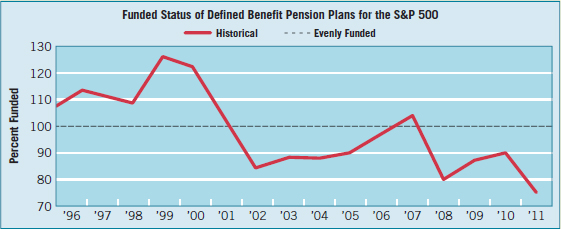
Source: D. Zion, A. Varshay, and N. Burnap, “From Bad to Worse,” Credit Suisse Equity Research (October 10, 2011).
REPORTING PENSION PLANS IN FINANCIAL STATEMENTS
LEARNING OBJECTIVE ![]()
Describe the requirements for reporting pension plans in financial statements.
As you might suspect, a phenomenon as significant and complex as pensions involves extensive reporting and disclosure requirements. We will cover these requirements in two categories: (1) those within the financial statements, and (2) those within the notes to the financial statements.
Within the Financial Statements
Recognition of the Net Funded Status of the Pension Plan
Companies must recognize on their balance sheet the overfunded (pension asset) or underfunded (pension liability) status of their defined benefit pension plan. The overfunded or underfunded status is measured as the difference between the fair value of the plan assets and the projected benefit obligation.
Classification of Pension Asset or Pension Liability
No portion of a pension asset is reported as a current asset. The excess of the fair value of the plan assets over the benefit obligation is classified as a noncurrent asset. The rationale for noncurrent classification is that the pension plan assets are restricted. That is, these assets are used to fund the projected benefit obligation, and therefore noncurrent classification is appropriate.
The current portion of a net pension liability represents the amount of benefit payments to be paid in the next 12 months (or operating cycle, if longer), if that amount cannot be funded from existing plan assets. Otherwise, the pension liability is classified as a noncurrent liability.14
Aggregation of Pension Plans
Some companies have two or more pension plans. In such instances, a question arises as to whether these multiple plans should be combined and shown as one amount on the balance sheet. The Board takes the position that all overfunded plans should be combined and shown as a pension asset on the balance sheet. Similarly, if the company has two or more underfunded plans, the underfunded plans are combined and shown as one amount on the balance sheet.
The FASB rejected the alternative of combining all plans and representing the net amount as a single net asset or net liability. The rationale: A company does not have the ability to offset excess assets of one plan against underfunded obligations of another plan. Furthermore, netting all plans is inappropriate because offsetting assets and liabilities is not permitted under GAAP unless a right of offset exists.
To illustrate, assume that Cresci Company has three pension plans as shown in Illustration 20-21.
In this case, Cresci reports a pension plan asset of $100,000 and a pension plan liability of $270,000 ($120,000 + $150,000).
Actuarial Gains and Losses/Prior Service Cost
Actuarial gains and losses not recognized as part of pension expense are recognized as increases and decreases in other comprehensive income. The same type of accounting is also used for prior service cost. The Board requires that the prior service cost arising in the year of the amendment (which increases the projected benefit obligation) be recognized by an offsetting debit to other comprehensive income. By recognizing both actuarial gains and losses and prior service cost as part of other comprehensive income, the Board believes that the usefulness of financial statements is enhanced.
To illustrate the presentation of other comprehensive income and related accumulated OCI, assume that Obey Company provides the following information for the year 2014. None of the Accumulated OCI on January 1, 2014, should be amortized in 2014.

Both the actuarial liability loss and the prior service adjustment decrease the funded status of the plan on the balance sheet. This results because the projected benefit obligation increases. However, neither the actuarial liability loss nor the prior service cost adjustment affects pension expense in 2014. In subsequent periods, these items will impact pension expense through amortization.
For Obey Company, the computation of “Other comprehensive loss” for 2014 is as follows.
The computation of “Comprehensive income” for 2014 is as follows.
The components of other comprehensive income must be reported in one of two ways: (1) in a second income statement, or (2) in a combined statement of comprehensive income. Regardless of the format used, net income must be added to other comprehensive income to arrive at comprehensive income. For homework purposes, use the second income statement approach unless stated otherwise. Earnings per share information related to comprehensive income is not required.
To illustrate the second income statement approach, assume that Obey Company has reported a traditional income statement. The comprehensive income statement is shown in Illustration 20-24.
The computation of “Accumulated other comprehensive income” as reported in stockholders' equity at December 31, 2014, is as follows.
Regardless of the display format for the income statement, the accumulated other comprehensive loss is reported in the stockholders' equity section of the balance sheet of Obey Company as shown in Illustration 20-26. (Illustration 20-26 uses assumed data for the common stock and retained earnings information.)
By providing information on the components of comprehensive income as well as total accumulated other comprehensive income, the company communicates all changes in net assets.
In this illustration, it is assumed that the accumulated other comprehensive income at January 1, 2014, is not adjusted for the amortization of any prior service cost or actuarial gains and losses that would change pension expense. As discussed in the earlier examples, these items will be amortized into pension expense in future periods.
Within the Notes to the Financial Statements
Pension plans are frequently important to understanding a company's financial position, results of operations, and cash flows. Therefore, a company discloses the following information, either in the body of the financial statements or in the notes.[7]
![]() International Perspective
International Perspective
The IASB and FASB are studying whether the various components of pension expense, such as interest cost and investment earnings on plan assets, should be presented separately in the income statement along with other interest expense and investment earnings.
- A schedule showing all the major components of pension expense.
Rationale: Information provided about the components of pension expense helps users better understand how a company determines pension expense. It also is useful in forecasting a company's net income. - A reconciliation showing how the projected benefit obligation and the fair value of the plan assets changed from the beginning to the end of the period.
Rationale: Disclosing the projected benefit obligation, the fair value of the plan assets, and changes in them should help users understand the economics underlying the obligations and resources of these plans. Explaining the changes in the projected benefit obligation and fair value of plan assets in the form of a reconciliation provides a more complete disclosure and makes the financial statements more understandable. - A disclosure of the rates used in measuring the benefit amounts (discount rate, expected return on plan assets, rate of compensation).
Rationale: Disclosure of these rates permits users to determine the reasonableness of the assumptions applied in measuring the pension liability and pension expense. - A table indicating the allocation of pension plan assets by category (equity securities, debt securities, real estate, and other assets), and showing the percentage of the fair value to total plan assets. In addition, a company must include a narrative description of investment policies and strategies, including the target allocation percentages (if used by the company).
Rationale: Such information helps financial statement users evaluate the pension plan's exposure to market risk and possible cash flow demands on the company. It also will help users better assess the reasonableness of the company's expected rate of return assumption. - The expected benefit payments to be paid to current plan participants for each of the next five fiscal years and in the aggregate for the five fiscal years thereafter. Also required is disclosure of a company's best estimate of expected contributions to be paid to the plan during the next year.
Rationale: These disclosures provide information related to the cash outflows of the company. With this information, financial statement users can better understand the potential cash outflows related to the pension plan. They can better assess the liquidity and solvency of the company, which helps in assessing the company's overall financial flexibility. - The nature and amount of changes in plan assets and benefit obligations recognized in net income and in other comprehensive income of each period.
Rationale: This disclosure provides information on pension elements affecting the projected benefit obligation and plan assets and on whether those amounts have been recognized in income or deferred to future periods. - The accumulated amount of changes in plan assets and benefit obligations that have been recognized in other comprehensive income and that will be recycled into net income in future periods.
Rationale: This information indicates the pension-related balances recognized in stockholders' equity, which will affect future income. - The amount of estimated net actuarial gains and losses and prior service costs and credits that will be amortized from accumulated other comprehensive income into net income over the next fiscal year.
Rationale: This information helps users predict the impact of deferred pension expense items on next year's income.
![]() Underlying Concepts
Underlying Concepts
Does it make a difference to users of financial statements whether companies recognize pension information in the financial statements or disclose it only in the notes? The FASB was unsure, so in accord with the full disclosure principle, it decided to provide extensive pension plan disclosures.
In summary, the disclosure requirements are extensive, and purposely so. One factor that has been a challenge for useful pension reporting has been the lack of consistent terminology. Furthermore, a substantial amount of offsetting is inherent in the measurement of pension expense and the pension liability. These disclosure requirements are designed to address these concerns and take some of the mystery out of pension reporting.
Example of Pension Note Disclosure
In the following sections, we provide examples and explain the key pension disclosure elements.
Components of Pension Expense
The FASB requires disclosure of the individual pension expense components (derived from the information in the pension expense worksheet column): (1) service cost, (2) interest cost, (3) expected return on assets, (4) other gains or losses component, and (5) prior service cost component. The purpose of such disclosure is to clarify to more sophisticated readers how companies determine pension expense. Providing information on the components should also be useful in predicting future pension expense.
Illustration 20-27 presents an example of this part of the disclosure. It uses the information from the Zarle illustration, specifically the expense component information from the worksheets in Illustrations 20-8 (page 1193), 20-12 (page 1196), and 20-18 (page 1203).
Funded Status of Plan
![]() Underlying Concepts
Underlying Concepts
This represents another compromise between relevance and faithful representation. Disclosure attempts to balance these objectives.
Having a reconciliation of the changes in the assets and liabilities from the beginning of the year to the end of the year, statement readers can better understand the underlying economics of the plan. In essence, this disclosure contains the information in the pension worksheet for the projected benefit obligation and plan asset columns. Using the information for Zarle, the schedule in Illustration 20-28 provides an example of the reconciliation.
The 2014 column reveals that Zarle underfunds the projected benefit obligation by $1,000. The 2015 column reveals that Zarle reports the underfunded liability of $78,600 in the balance sheet. Finally, the 2016 column indicates that Zarle recognizes the underfunded liability of $105,400 in the balance sheet.
2017 Entries and Worksheet—A Comprehensive Example
Incorporating the corridor computation and the required disclosures, we continue the Zarle Company pension plan accounting based on the following facts for 2017.
Service cost is $16,000.
Settlement rate is 10 percent; expected rate of return is 10 percent.
Actual return on plan assets is $22,000.
Amortization of prior service cost is $17,600.
Annual funding contributions are $27,000.
Benefits paid to retirees during the year are $18,000.
Average service life of all covered employees is 20 years.
Zarle prepares a worksheet to facilitate accumulation and recording of the components of pension expense and maintenance of amounts related to the pension plan. Illustration 20-29 shows that worksheet, which uses the basic data presented above. Beginning-of-the-year 2017 account balances are the December 31, 2016, balances from Zarle's revised 2016 pension worksheet in Illustration 20-18 (on page 1203).
Worksheet Explanations and Entries
Entries (aa) through (gg) are similar to the corresponding entries previously explained in the prior years' worksheets, with the exception of entry (dd). In 2016, the expected return on plan assets exceeded the actual return, producing an unexpected loss. In 2017, the actual return of $22,000 exceeds the expected return of $15,960 ($159,600 × 10%), resulting in an unexpected gain of $6,040, entry (dd). By netting the gain of $6,040 against the actual return of $22,000, pension expense is affected only by the expected return of $15,960.
A new entry (hh) in Zarle's worksheet results from application of the corridor test on the accumulated balance of net gain or loss in accumulated other comprehensive income. Zarle Company begins 2017 with a balance in the net loss account of $29,940. The company applies the corridor criterion in 2017 to determine whether the balance is excessive and should be amortized. In 2017, the corridor is 10 percent of the larger of the beginning-of-the-year projected benefit obligation of $265,000 or the plan asset's $159,600 market-related asset value (assumed to be fair value). The corridor for 2017 is $26,500 ($265,000 × 10%). Because the balance in Accumulated OCI is a net loss of $29,940, the excess (outside the corridor) is $3,440 ($29,940 − $26,500). Zarle amortizes the $3,440 excess over the average remaining service life of all employees. Given an average remaining service life of 20 years, the amortization in 2017 is $172 ($3,440 ÷ 20). In the 2017 pension worksheet, Zarle debits Pension Expense for $172 and credits that amount to Other Comprehensive Income (G/L). Illustration 20-30 shows the computation of the $172 amortization charge.
Zarle formally records pension expense for 2017 as follows.

Note Disclosure
Illustration 20-31 (page 1212) shows the note disclosure of Zarle's pension plan for 2017. Note that this example assumes that the pension liability is noncurrent and that the 2018 adjustment for amortization of the net gain or loss and amortization of prior service cost are the same as 2017.
Special Issues
The Pension Reform Act of 1974
A classic example of the unfortunate consequences of an underfunded pension plan is the 1963 shutdown of the Studebaker Automobile operations in South Bend, Indiana, in which 4,500 workers lost 85 percent of their vested benefits. As a result of such situations, the Employee Retirement Income Security Act of 1974—ERISA—was passed. The legislation affects virtually every private retirement plan in the United States. It attempts to safeguard employees' pension rights by mandating many pension plan requirements, including minimum funding, participation, and vesting.
These requirements can influence the employers' cash flows significantly. Under this legislation, annual funding is no longer discretionary. An employer now must fund the plan in accordance with an actuarial funding method that over time will be sufficient to pay for all pension obligations. If companies do not fund their plans in a reasonable manner, they may be subject to fines and/or loss of tax deductions.15
![]() Underlying Concepts
Underlying Concepts
Many plans are underfunded but still quite viable. For example, at one time Loews Corp. had a $159 million shortfall, but also had earnings of $594 million and a good net worth. Thus, the going concern assumption permits us to ignore pension underfundings in some cases because in the long run they are not significant.
The law requires plan administrators to publish a comprehensive description and summary of their plans, along with detailed annual reports that include many supplementary schedules and statements.
Another important provision of the act is the creation of the Pension Benefit Guaranty Corporation (PBGC). The PBGC's purpose is to administer terminated plans and to impose liens on an employer's assets for certain unfunded pension liabilities. If a company terminates its pension plan, the PBGC can effectively impose a lien against the employer's assets for the excess of the present value of guaranteed vested benefits over the pension fund assets. This lien generally has had the status of a tax lien; it takes priority over most other creditorship claims. This section of the act gives the PBGC the power to force an involuntary termination of a pension plan whenever the risks related to nonpayment of the pension obligation seem too great. Because ERISA restricts to 30 percent of net worth the lien that the PBGC can impose, the PBGC must monitor all plans to ensure that net worth is sufficient to meet the pension benefit obligations.
A large number of terminated plans have caused the PBGC to pay out substantial benefits. Currently the PBGC receives its funding from employers, who contribute a certain dollar amount for each employee covered under the plan.16
What do the numbers mean? WHO GUARANTEES THE GUARANTOR?
The Pension Benefit Guaranty Corporation (PBGC) in its 2012 annual report indicates that its primary mission is to encourage the continuation and maintenance of voluntary private pension plans. It's an obligation which the PBGC takes seriously. However, the trends are ominous:
- Americans today are spending more years in retirement. They're healthier and more active, which is great news. Unfortunately, pensions haven't kept up.
- Many businesses, for competitive and other reasons, continue to reduce their support for retirement plans. Some have switched from a defined benefit plan to a defined contribution plan which costs less and comes with fewer obligations. Others offer lump-sum cash payments to employees or retirees to settle the employer's obligations.
- Left on their own, many people save less, as well as invest and plan less well. They also pay higher fees and they get lower returns.
- Many people defer retirement but still don't have enough money for retirement—and they're worried. One poll cited by the Senate Health, Education, Labor, and Pensions Committee says that 92 percent of people think there's a retirement crisis. They're right to be concerned.
Add to these concerns that obligations in pension plans today greatly exceed pension assets. Finally, the PBGC has a problem as well—a large deficit in its accounts. The chart on page 1214 indicates that downward spiral in the net worth of the PBGC over the last 10 years.
In February 2012, American Airlines announced that it is ending its defined benefit plans, which would result in the PBGC having to increase its deficit even more to an estimated $35 billion. The result is a growing deficit problem which is likely to continue. Who has the risk? You guessed it, the American taxpayer.
Source: Alex Pollock, “The Pension Benefit Guaranty Corporation: Who Will Guarantee This Guarantor?” 2012 Annual Report of the Pension Benefit Guarantee Corporation (June 26, 2012).
Pension Terminations
A congressman at one time noted, “Employers are simply treating their employee pension plans like company piggy banks, to be raided at will.” What this congressman was referring to is the practice of paying off the projected benefit obligation and pocketing any excess. ERISA prevents companies from recapturing excess assets unless they pay participants what is owed to them and then terminate the plan. As a result, companies were buying annuities to pay off the pension claimants and then used the excess funds for other corporate purposes.17
For example, at one time, pension plan terminations netted $363 million for Occidental Petroleum Corp., $95 million for Stroh's Brewery Co., $58 million for Kellogg Co., and $29 million for Western Airlines. Recently, many large companies have terminated their pension plans and captured billions in surplus assets. The U.S. Treasury also benefits: Federal legislation requires companies to pay an excise tax of anywhere from 20 percent to 50 percent on the gains. All of this is quite legal.18
The accounting issue that arises from these terminations is whether a company should recognize a gain when pension plan assets revert back to the company (often called asset reversion transactions). The issue is complex. In some cases, a company starts a new defined benefit plan after it eliminates the old one. Thus, some contend that there has been no change in substance but merely a change in form. However, the FASB disagrees. It requires recognition in earnings of a gain or loss when the employer settles a pension obligation either by lump-sum cash payments to participants or by purchasing nonparticipating annuity contracts.[8]19
Concluding Observations
![]() You will want to read the IFRS INSIGHTS on pages 1250–1266 for discussion of IFRS related to pension accounting.
You will want to read the IFRS INSIGHTS on pages 1250–1266 for discussion of IFRS related to pension accounting.
Hardly a day goes by without the financial press analyzing in depth some issue related to pension plans in the United States. This is not surprising, since pension funds exceed over $22 trillion in assets globally. As you have seen, the accounting issues related to pension plans are complex. Recent changes to GAAP have clarified many of these issues and should help users understand the financial implications of a company's pension plans on its financial position, results of operations, and cash flows.
KEY TERMS
accumulated benefit obligation, 1187
actual return on plan assets, 1191
actuarial present value, 1188(n)
actuaries, 1187
asset gains and losses, 1198
cash-balance plans, 1214(n)
components of pension expense, 1190
contributory pension plan, 1184
corridor approach, 1199
defined benefit plan, 1185
defined contribution plan, 1185
ERISA, 1211
expected rate of return, 1197
expected return on plan assets, 1197
fair value of plan assets, 1191
funded pension plan, 1184
funded status (overfunded or underfunded), 1189
interest on the liability (interest expense), 1191
liability gains and losses, 1198
market-related asset value, 1198
noncontributory pension plan, 1184
Other Comprehensive Income (G/L), 1198
Other Comprehensive Income (PSC), 1197
pension asset/liability, 1192
pension plan, 1184
pension worksheet, 1192
prior service cost (PSC), 1194
projected benefit obligation, 1188
qualified pension plan, 1184
reconciliation, 1207
retroactive benefits, 1194
service cost, 1190
settlement rate, 1191
unexpected gain or loss, 1198
vested benefit obligation, 1187
vested benefits, 1187
years-of-service method, 1194
SUMMARY OF LEARNING OBJECTIVES
![]() Distinguish between accounting for the employer's pension plan and accounting for the pension fund. The company or employer is the organization sponsoring the pension plan. It incurs the cost and makes contributions to the pension fund. The fund or plan is the entity that receives the contributions from the employer, administers the pension assets, and makes the benefit payments to the pension recipients (retired employees). The fund should be a separate legal and accounting entity; it maintains a set of books and prepares financial statements.
Distinguish between accounting for the employer's pension plan and accounting for the pension fund. The company or employer is the organization sponsoring the pension plan. It incurs the cost and makes contributions to the pension fund. The fund or plan is the entity that receives the contributions from the employer, administers the pension assets, and makes the benefit payments to the pension recipients (retired employees). The fund should be a separate legal and accounting entity; it maintains a set of books and prepares financial statements.
![]() Identify types of pension plans and their characteristics. The two most common types of pension arrangements are as follows. (1) Defined contribution plans: The employer agrees to contribute to a pension trust a certain sum each period based on a formula. This formula may consider such factors as age, length of employee service, employer's profits, and compensation level. Only the employer's contribution is defined; no promise is made regarding the ultimate benefits paid out to the employees. (2) Defined benefit plans: These plans define the benefits that the employee will receive at the time of retirement. The formula typically provides for the benefits to be a function of the employee's years of service and the compensation level when he or she nears retirement.
Identify types of pension plans and their characteristics. The two most common types of pension arrangements are as follows. (1) Defined contribution plans: The employer agrees to contribute to a pension trust a certain sum each period based on a formula. This formula may consider such factors as age, length of employee service, employer's profits, and compensation level. Only the employer's contribution is defined; no promise is made regarding the ultimate benefits paid out to the employees. (2) Defined benefit plans: These plans define the benefits that the employee will receive at the time of retirement. The formula typically provides for the benefits to be a function of the employee's years of service and the compensation level when he or she nears retirement.
![]() Explain alternative measures for valuing the pension obligation. One measure bases the pension obligation only on the benefits vested to the employees. Vested benefits are those that the employee is entitled to receive even if he or she renders no additional services under the plan. Companies compute the vested benefit pension obligation using current salary levels; this obligation includes only vested benefits. Another measure of the obligation, called the accumulated benefit obligation, computes the deferred compensation amount based on all years of service performed by employees under the plan—both vested and nonvested—using current salary levels. A third measure, called the projected benefit obligation, bases the computation of the deferred compensation amount on both vested and nonvested service using future salaries.
Explain alternative measures for valuing the pension obligation. One measure bases the pension obligation only on the benefits vested to the employees. Vested benefits are those that the employee is entitled to receive even if he or she renders no additional services under the plan. Companies compute the vested benefit pension obligation using current salary levels; this obligation includes only vested benefits. Another measure of the obligation, called the accumulated benefit obligation, computes the deferred compensation amount based on all years of service performed by employees under the plan—both vested and nonvested—using current salary levels. A third measure, called the projected benefit obligation, bases the computation of the deferred compensation amount on both vested and nonvested service using future salaries.
![]() List the components of pension expense. Pension expense is a function of the following components: (1) service cost, (2) interest on the liability, (3) return on plan assets, (4) amortization of prior service cost, and (5) gain or loss.
List the components of pension expense. Pension expense is a function of the following components: (1) service cost, (2) interest on the liability, (3) return on plan assets, (4) amortization of prior service cost, and (5) gain or loss.
![]() Use a worksheet for employer's pension plan entries. Companies may use a worksheet unique to pension accounting. This worksheet records both the formal entries and the memo entries to keep track of all the employer's relevant pension plan items and components.
Use a worksheet for employer's pension plan entries. Companies may use a worksheet unique to pension accounting. This worksheet records both the formal entries and the memo entries to keep track of all the employer's relevant pension plan items and components.
![]() Describe the amortization of prior service costs. An actuary computes the amount of the prior service cost, and the company then records it as an adjustment to the projected benefit obligation and other comprehensive income. It then amortizes it, generally using a “years-of-service” amortization method, similar to a units-of-production computation. First, the company computes total estimated number of service-years to be worked by all of the participating employees. Second, it divides the accumulated prior service cost by the total number of service-years, to obtain a cost per service-year (the unit cost). Third, the company multiplies the number of service-years consumed each year times the cost per service-year, to obtain the annual amortization charge.
Describe the amortization of prior service costs. An actuary computes the amount of the prior service cost, and the company then records it as an adjustment to the projected benefit obligation and other comprehensive income. It then amortizes it, generally using a “years-of-service” amortization method, similar to a units-of-production computation. First, the company computes total estimated number of service-years to be worked by all of the participating employees. Second, it divides the accumulated prior service cost by the total number of service-years, to obtain a cost per service-year (the unit cost). Third, the company multiplies the number of service-years consumed each year times the cost per service-year, to obtain the annual amortization charge.
![]() Explain the accounting for unexpected gains and losses. In estimating the projected benefit obligation (the liability), actuaries make assumptions about such items as mortality rate, retirement rate, turnover rate, disability rate, and salary amounts. Any change in these actuarial assumptions affects the amount of the projected benefit obligation. These unexpected gains or losses from changes in the projected benefit obligation are liability gains and losses. Liability gains result from unexpected decreases in the liability balance; liability losses result from unexpected increases. Companies also incur asset gains or losses. Both types of actuarial gains and losses are recorded in other comprehensive income and adjust either the projected benefit obligation or the plan assets.
Explain the accounting for unexpected gains and losses. In estimating the projected benefit obligation (the liability), actuaries make assumptions about such items as mortality rate, retirement rate, turnover rate, disability rate, and salary amounts. Any change in these actuarial assumptions affects the amount of the projected benefit obligation. These unexpected gains or losses from changes in the projected benefit obligation are liability gains and losses. Liability gains result from unexpected decreases in the liability balance; liability losses result from unexpected increases. Companies also incur asset gains or losses. Both types of actuarial gains and losses are recorded in other comprehensive income and adjust either the projected benefit obligation or the plan assets.
![]() Explain the corridor approach to amortizing gains and losses. The FASB set a limit for the size of an accumulated net gain or loss balance. That arbitrarily selected limit (called a corridor) is 10 percent of the larger of the beginning balances of the projected benefit obligation or the market-related value of the plan assets. Beyond that limit, an accumulated net gain or loss balance is considered too large and must be amortized. If the balance of the accumulated net gain or loss account stays within the upper and lower limits of the corridor, no amortization is required.
Explain the corridor approach to amortizing gains and losses. The FASB set a limit for the size of an accumulated net gain or loss balance. That arbitrarily selected limit (called a corridor) is 10 percent of the larger of the beginning balances of the projected benefit obligation or the market-related value of the plan assets. Beyond that limit, an accumulated net gain or loss balance is considered too large and must be amortized. If the balance of the accumulated net gain or loss account stays within the upper and lower limits of the corridor, no amortization is required.
![]() Describe the requirements for reporting pension plans in financial statements. Currently, companies must disclose the following pension plan information in their financial statements. (1) The components of pension expense for the period. (2) A schedule showing changes in the benefit obligation and plan assets during the year. (3) The amount of prior service cost and net gains and losses in accumulated OCI, including the estimated prior service cost and gains and losses that will affect net income in the next year. (4) The weighted-average assumed discount rate, the rate of compensation increase used to measure the projected benefit obligation, and the weighted-average expected long-term rate of return on plan assets. (5) A table showing the allocation of pension plan assets by category and the percentage of the fair value to total plan assets. (6) The expected benefit payments for current plan participants for each of the next five fiscal years and for the following five years in aggregate, along with an estimate of expected contributions to the plan during the next year.
Describe the requirements for reporting pension plans in financial statements. Currently, companies must disclose the following pension plan information in their financial statements. (1) The components of pension expense for the period. (2) A schedule showing changes in the benefit obligation and plan assets during the year. (3) The amount of prior service cost and net gains and losses in accumulated OCI, including the estimated prior service cost and gains and losses that will affect net income in the next year. (4) The weighted-average assumed discount rate, the rate of compensation increase used to measure the projected benefit obligation, and the weighted-average expected long-term rate of return on plan assets. (5) A table showing the allocation of pension plan assets by category and the percentage of the fair value to total plan assets. (6) The expected benefit payments for current plan participants for each of the next five fiscal years and for the following five years in aggregate, along with an estimate of expected contributions to the plan during the next year.
APPENDIX 20A ACCOUNTING FOR POSTRETIREMENT BENEFITS
LEARNING OBJECTIVE ![]()
Identify the differences between pensions and postretirement healthcare benefits.
IBM's adoption of the GAAP requirements on postretirement benefits resulted in a $2.3 billion charge and a historical curiosity—IBM's first-ever quarterly loss. General Electric disclosed that its charge for adoption of the same GAAP rules would be $2.7 billion. AT&T absorbed a $2.1 billion pretax hit for postretirement benefits upon adoption. What is GAAP in this area, and how could its adoption have so grave an impact on companies' earnings?
ACCOUNTING GUIDANCE
After a decade of study, the FASB in December 1990 issued GAAP for “Employers' Accounting for Postretirement Benefits Other Than Pensions.” [9] It alone was the cause for the large charges to income cited above. These rules cover for healthcare and other “welfare benefits” provided to retirees, their spouses, dependents, and beneficiaries.20 These other welfare benefits include life insurance offered outside a pension plan; medical, dental, and eye care; legal and tax services; tuition assistance; day care; and housing assistance.21 Because healthcare benefits are the largest of the other postretirement benefits, we use this item to illustrate accounting for postretirement benefits.
For many employers (about 95 percent), these GAAP rules required a change from the predominant practice of accounting for postretirement benefits on a pay-as-you-go (cash) basis to an accrual basis. Similar to pension accounting, the accrual basis necessitates measuring the employer's obligation to provide future benefits and accrual of the cost during the years that the employee provides service.
One of the reasons companies had not prefunded these benefit plans was that payments to prefund healthcare costs, unlike excess contributions to a pension trust, are not tax-deductible. Another reason was that postretirement healthcare benefits were once perceived to be a low-cost employee benefit that could be changed or eliminated at will and therefore were not a legal liability. Now, the accounting definition of a liability goes beyond the notion of a legally enforceable claim; the definition now encompasses equitable or constructive obligations as well, making it clear that the postretirement benefit promise is a liability.22
DIFFERENCES BETWEEN PENSION BENEFITS AND HEALTHCARE BENEFITS
The FASB used the GAAP rules on pensions as a reference for the accounting prescribed for healthcare and other nonpension postretirement benefits.23 Why didn't the FASB cover these other types of postretirement benefits in the earlier pension accounting statement? Because the apparent similarities between the two benefits mask some significant differences. Illustration 20A-1 shows these differences.24
Two of the differences in Illustration 20A-1 highlight why measuring the future payments for healthcare benefit plans is so much more difficult than for pension plans.
- Many postretirement plans do not set a limit on healthcare benefits. No matter how serious the illness or how long it lasts, the benefits continue to flow. (Even if the employer uses an insurance company plan, the premiums will escalate according to the increased benefits provided.)
- The levels of healthcare benefit use and healthcare costs are difficult to predict. Increased longevity, unexpected illnesses (e.g., AIDS, SARS, and avian flu), along with new medical technologies and cures, cause changes in healthcare utilization.
Additionally, although the fiduciary and reporting standards for employee benefit funds under government regulations generally cover healthcare benefits, the stringent minimum vesting, participation, and funding standards that apply to pensions do not apply to healthcare benefits. Nevertheless, as you will learn, many of the basic concepts of pensions, and much of the related accounting terminology and measurement methodology, do apply to other postretirement benefits. Therefore, in the following discussion and illustrations, we point out the similarities and differences in the accounting and reporting for these two types of postretirement benefits.
What do the numbers mean? OPEBs—HOW BIG ARE THEY?
For many companies, other postretirement benefit obligations (OPEBs) are substantial. Generally, OPEBs are not well funded because companies are not permitted a tax deduction for contributions to the plan assets, as is the case with pensions. That is, the company may not claim a tax deduction until it makes a payment to the participant (pay-as-you-go).
Presented below are companies with the largest OPEB obligations, indicating their relationship with other financial items.

So, how big are OPEB obligations? REALLY big.
Source: Company reports.
POSTRETIREMENT BENEFITS ACCOUNTING PROVISIONS
Healthcare and other postretirement benefits for current and future retirees and their dependents are forms of deferred compensation. They are earned through employee service and are subject to accrual during the years an employee is working.
The period of time over which the postretirement benefit cost accrues is called the attribution period. It is the period of service during which the employee earns the benefits under the terms of the plan. The attribution period, shown in Illustration 20A-2 for a hypothetical employee, generally begins when an employee is hired and ends on the date the employee is eligible to receive the benefits and ceases to earn additional benefits by performing service, the vesting date.25
Obligations Under Postretirement Benefits
In defining the obligation for postretirement benefits, the FASB maintained many concepts similar to pension accounting. It also designed some new and modified terms specifically for postretirement benefits. Two of the most important of these specialized terms are (a) expected postretirement benefit obligation and (b) accumulated postretirement benefit obligation.
The expected postretirement benefit obligation (EPBO) is the actuarial present value as of a particular date of all benefits a company expects to pay after retirement to employees and their dependents. Companies do not record the EPBO in the financial statements, but they do use it in measuring periodic expense.
The accumulated postretirement benefit obligation (APBO) is the actuarial present value of future benefits attributed to employees' services rendered to a particular date. The APBO is equal to the EPBO for retirees and active employees fully eligible for benefits. Before the date an employee achieves full eligibility, the APBO is only a portion of the EPBO. Or stated another way, the difference between the APBO and the EPBO is the future service costs of active employees who are not yet fully eligible.
Illustration 20A-3 contrasts the EPBO and the APBO. At the date an employee is fully eligible (the end of the attribution period), the APBO and the EPBO for that employee are equal.
Postretirement Expense
Postretirement expense is the employer's annual expense for postretirement benefits. Also called net periodic postretirement benefit cost, this expense consists of many of the familiar components used to compute annual pension expense. The components of net periodic postretirement benefit cost are as follows. [11]26
- Service cost. The portion of the EPBO attributed to employee service during the period.
- Interest cost. The increase in the APBO attributable to the passage of time. Companies compute interest cost by applying the beginning-of-the-year discount rate to the beginning-of-the-year APBO, adjusted for benefit payments to be made during the period. The discount rate is based on the rates of return on high-quality, fixed-income investments that are currently available.27
- Actual return on plan assets. The change in the fair value of the plan's assets adjusted for contributions and benefit payments made during the period. Because companies charge or credit the postretirement expense for the gain or loss on plan assets (the difference between the actual and the expected return), this component is actually the expected return.
- Amortization of prior service cost. The amortization of the cost of retroactive benefits resulting from plan amendments. The typical amortization period, beginning at the date of the plan amendment, is the remaining service periods through the full eligibility date.
- Gains and losses. In general, changes in the APBO resulting from changes in assumptions or from experience different from that assumed. For funded plans, this component also includes the difference between actual return and expected return on plan assets.
ILLUSTRATIVE ACCOUNTING ENTRIES
LEARNING OBJECTIVE ![]()
Contrast accounting for pensions to accounting for other postretirement benefits.
Like pension accounting, the accounting for postretirement plans must recognize in the accounts and in the financial statements effects of several significant items. These items are:
- Expected postretirement benefit obligation (EPBO).
- Accumulated postretirement benefit obligation (APBO).
- Postretirement benefit plan assets.
- Prior service cost.
- Net gain or loss.
The EPBO is not recognized in the financial statements or disclosed in the notes. Companies recompute it each year, and the actuary uses it in measuring the annual service cost. Because of the numerous assumptions and actuarial complexity involved in measuring annual service cost, we have omitted these computations of the EPBO.
Similar to pensions, companies must recognize in the financial statements items 2 through 5 listed above. In addition, as in pension accounting, companies must know the exact amount of these items in order to compute postretirement expense. Therefore, companies use the worksheet like that for pension accounting to record both the formal general journal entries and the memo entries.
2014 Entries and Worksheet
To illustrate the use of a worksheet in accounting for a postretirement benefits plan, assume that on January 1, 2014, Quest Company adopts a healthcare benefit plan. The following facts apply to the postretirement benefits plan for the year 2014.
Plan assets at fair value on January 1, 2014, are zero.
Actual and expected returns on plan assets are zero.
Accumulated postretirement benefit obligation (APBO), January 1, 2014, is zero.
No prior service cost exists.
Interest cost on the APBO is zero.
Funding contributions during the year are $38,000.
Benefit payments to employees from plan are $28,000.
Using that data, the worksheet in Illustration 20A-4 presents the postretirement entries for 2014.
Entry (a) records the service cost component, which increases postretirement expense $54,000 and increases the liability (APBO) $54,000. Entry (b) records Quest's funding of assets to the postretirement fund. The funding decreases cash $38,000 and increases plan assets $38,000. Entry (c) records the benefit payments made to retirees, which results in equal $28,000 decreases to the plan assets and the liability (APBO).
Quest's December 31 adjusting entry formally records the postretirement expense in 2014, as follows.

The credit to Postretirement Asset/Liability for $16,000 represents the difference between the APBO and the plan assets. The $16,000 credit balance is a liability because the plan is underfunded. The Postretirement Asset/Liability account balance of $16,000 also equals the net of the balances in the memo accounts.
Illustration 20A-5 shows the funded status reported in the balance sheet. (Notice its similarity to the pension schedule.)
Recognition of Gains and Losses
Gains and losses represent changes in the APBO or the value of plan assets. These changes result either from actual experience different from that expected or from changes in actuarial assumptions. The amortization of these gains and losses follows the approach used for pensions. That is, the gains and losses are recorded in other comprehensive income.
The Corridor Approach
Consistent with pension accounting, companies amortize the gains and losses in accumulated other comprehensive income as a component of postretirement expense if, at the beginning of the period, they exceed a “corridor” limit. The corridor is measured as the greater of 10 percent of the APBO or 10 percent of the market-related value of plan assets.
The intent of the corridor approach is to reduce volatility of postretirement expense by providing a reasonable opportunity for gains and losses to offset over time without affecting net periodic expense.
Amortization Methods
If the company must amortize gains and losses (beyond the corridor) on postretirement benefit plans, the minimum amortization amount is the excess gain or loss divided by the average remaining service life to expected retirement of all active employees. Companies may use any systematic method of amortization provided that: (1) the amount amortized in any period is equal to or greater than the minimum amount, (2) the company applies the method consistently, and (3) the company applies the method similarly for gains and losses.
The company must recompute the amount of gain or loss in accumulated other comprehensive income each year and amortize the gain or loss over the average remaining service life if the net amount exceeds the “corridor.”
2015 Entries and Worksheet
Continuing the Quest Company illustration into 2015, the following facts apply to the postretirement benefits plan for the year 2015.
Actual return on plan assets is $600.
Expected return on plan assets is $800.
Discount rate is 8 percent.
Increase in APBO due to change in actuarial assumptions is $60,000.
Service cost is $26,000.
Funding contributions during the year are $18,000.
Benefit payments to employees during the year are $5,000.
Average remaining service to expected retirement: 25 years.
The worksheet in Illustration 20A-6 (on page 1224) presents all of Quest's postretirement benefit entries and information for 2015. The beginning balances on the first line of the worksheet are the ending balances from Quest's 2014 postretirement benefits worksheet in Illustration 20A-4 (on page 1222).
Entries (d), (h), and (i) are similar to the corresponding entries previously explained for 2014. Entry (e) accrues the interest expense component, which increases both the liability and the postretirement expense by $2,080 (the beginning APBO multiplied by the discount rate of 8%). Entries (f) and (g) are related. The expected return of $800 is higher than the actual return of $600. To smooth postretirement expense, Quest defers the unexpected loss of $200 ($800 − $600) by debiting Other Comprehensive Income (G/L) and crediting Postretirement Expense. As a result of this adjustment, the expected return on the plan assets is the amount actually used to compute postretirement expense.
Entry (j) records the change in the APBO resulting from a change in actuarial assumptions. This $60,000 increase in the employer's accumulated liability is an unexpected loss. Quest debits this loss to Other Comprehensive Income (G/L).
On December 31 Quest formally records net periodic expense for 2015 as follows.

The balance of the Postretirement Asset/Liability account at December 31, 2015, is $85,480. This balance is equal to the net of the balances in the memo accounts as shown in the reconciliation schedule in Illustration 20A-7.
Amortization of Net Gain or Loss in 2016
Quest has a beginning balance in Accumulated OCI related to losses of $60,200. Therefore, Quest must apply the corridor test for amortization of the balance for 2016. Illustration 20A-8 shows the computation of the amortization charge for the loss.
DISCLOSURES IN NOTES TO THE FINANCIAL STATEMENTS
The disclosures required for other postretirement benefit plans are similar to and just as detailed and extensive as those required for pensions. The note disclosure for Tootsie Roll, Inc. in Illustration 20A-9 (page 1226) provides a good example of the extensive disclosure required for other postretirement benefit plans.
As indicated in Illustration 20A-9, Tootsie Roll shows the impact of the postretirement benefit plan on income, the balance sheet, and the cash flow statement, and it provides information on important assumptions used in the measurement of the postretirement benefit obligation. Also note that given no tax incentives for funding, Tootsie Roll (like many companies) does not have any assets set aside for its other postretirement benefit obligations.
While Tootsie Roll has only an other postretirement benefit plan, many companies sponsor both defined benefit pension and other postretirement plans. Given the similarities in accounting for these plans, companies can combine pension and other postretirement benefit disclosures.
ACTUARIAL ASSUMPTIONS AND CONCEPTUAL ISSUES
Measurement of the EPBO, the APBO, and the net periodic postretirement benefit cost is involved and complex. Due to the uncertainties in forecasting healthcare costs, rates of use, changes in government health programs, and the differences employed in non-medical assumptions (e.g., discount rate, employee turnover, rate of pre-65 retirement, spouse-age difference), estimates of postretirement benefit costs may have a large margin of error. Is the information relevant, reliable, or verifiable? The FASB concluded that “the obligation to provide postretirement benefits meets the definition of a liability, is representationally faithful, is relevant to financial statement users, and can be measured with sufficient reliability at a justifiable cost.” [12] Failure to accrue an obligation and an expense prior to payment of benefits would result in an unfaithful representation of what financial statements should represent.
The FASB took a momentous step by requiring recognition of a postretirement liability. Many opposed the requirement, warning that the GAAP rules would devastate earnings. Others argued that putting these numbers on the balance sheet was inappropriate. Others noted that the requirement would force companies to curtail postretirement benefits to employees.
The authors believe that the FASB deserves special praise. Because the Board addressed this issue, companies now recognize the magnitude of these costs. This recognition has led to efforts to control escalating healthcare costs. As John Ruffle, a former president of the Financial Accounting Foundation noted, “The Board has done American industry a gigantic favor. Over the long term, industry will look back and say thanks.”
What do the numbers mean? WANT SOME BAD NEWS?
Many companies have underfunded pension and other postretirement plans. Unfortunately, many governmental entities also have the same problem but on a much larger scale. Here are some examples.
- The actual liabilities of the federal government—including Social Security, Medicare, and federal employees' future retirement benefits—is estimated to be $86.8 trillion or 550 percent of GDP at the end of 2011. When the accrued expenses of the government's entitled programs are counted, we need to collect over $8 trillion in tax revenues annually. Even if you take all the taxable income of corporations and of individuals earning over approximately $66,000, that still falls short of the $8 trillion.
- A State Budget Crisis Task Force recently declared underfunded retirement promises as one of the six major threats to states' “fiscal sustainability.”
- According to the Milliman's Public Pension Fund Study and the Pew Center for the States Report, an $859 billion gap exists between obligations for the country's 100 largest public pension plans and the funding of these plans. Nine states were 60 percent funded or less. In Illinois, just 45 percent of the state's pension liabilities were funded. California alone had $113 billion in unfunded liability.
So what does all this have to do with accounting? Similar to the FASB, there is an organization called the Governmental Accounting Standards Board (GASB), which establishes standards of financial accounting and reporting for state and local governmental agencies.
Until recently, the GASB went about its work in relative obscurity. How did the GASB get everyone's attention? It recently required that governmental units recognize postretirement benefits on their balance sheets on an accrual basis. Some states do not like this requirement and have proposed legislation that will allow them to ignore GASB standards. However, the GASB, with the support of users of government reports, has pushed for the change. They are concerned that without the new requirements, governments will continue to misrepresent the true cost of their retirement-related promises to public employees. In their view, the new accounting rules are in the best interests of municipal bondholders and the public in general. Thus, it appears that the FASB is not the only standard-setter subject to political pressure.
Sources: R. H. Attmore, “Who Do Texas Elected Officials Think They Are Fooling?” The Bond Buyer (June 18, 2007); Chris Cox and Bill Archer, “Why $16 Trillion Only Hints at the True U.S. Debt,” Wall Street Journal (November 27, 2012); and “More Bad News for Public Pensions,” Wall Street Journal (July 12, 2012). For more information on the GASB, go to www.gasb.org/.
KEY TERMS
accumulated postretirement benefit obligation (APBO), 1220
attribution period, 1219
corridor approach, 1223
expected postretirement benefit obligation (EPBO), 1220
SUMMARY OF LEARNING OBJECTIVES FOR APPENDIX 20A
![]() Identify the differences between pensions and postretirement healthcare benefits. Pension plans are generally funded, but healthcare benefit plans are not. Pension benefits are generally well-defined and level in amount; healthcare benefits are generally uncapped and variable. Pension benefits are payable monthly; healthcare benefits are paid as needed and used. Pension plan variables are reasonably predictable, whereas healthcare plan variables are difficult to predict.
Identify the differences between pensions and postretirement healthcare benefits. Pension plans are generally funded, but healthcare benefit plans are not. Pension benefits are generally well-defined and level in amount; healthcare benefits are generally uncapped and variable. Pension benefits are payable monthly; healthcare benefits are paid as needed and used. Pension plan variables are reasonably predictable, whereas healthcare plan variables are difficult to predict.
![]() Contrast accounting for pensions to accounting for other postretirement benefits. Many of the basic concepts, accounting terminology, and measurement methodology that apply to pensions also apply to other postretirement benefit accounting. Because other postretirement benefit plans are unfunded, large obligations can occur. Two significant concepts peculiar to accounting for other postretirement benefits are (1) expected postretirement benefit obligation (EPBO), and (2) accumulated postretirement benefit obligation (APBO).
Contrast accounting for pensions to accounting for other postretirement benefits. Many of the basic concepts, accounting terminology, and measurement methodology that apply to pensions also apply to other postretirement benefit accounting. Because other postretirement benefit plans are unfunded, large obligations can occur. Two significant concepts peculiar to accounting for other postretirement benefits are (1) expected postretirement benefit obligation (EPBO), and (2) accumulated postretirement benefit obligation (APBO).
DEMONSTRATION PROBLEM
Jablonski Corp. sponsors a defined benefit pension plan for its employees. On January 1, 2014, the following balances related to this plan.

As a result of the operation of the plan during 2014, the actuary provided the following additional data at December 31, 2014.
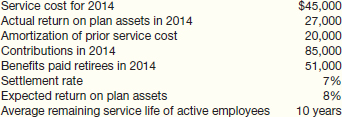
Instructions
(a) Compute pension expense for Jablonski Corp. for the year 2014 by preparing a pension worksheet that shows the journal entry for pension expense.
(b) Indicate the pension amounts reported in the financial statements.
 FASB CODIFICATION
FASB CODIFICATION
FASB Codification References
[1] FASB ASC 960. [Predecessor literature: “Accounting and Reporting by Defined Benefit Pension Plans,” Statement of Financial Accounting Standards No. 35 (Stamford, Conn.: FASB, 1979).]
[2] FASB ASC 715-70-50-1. [Predecessor literature: “Employers' Accounting for Pension Plans,” Statement of Financial Accounting Standards No. 87 (Stamford, Conn.: FASB, 1985), paras. 63–66.]
[3] FASB ASC 715-30-25-1. [Predecessor literature: “Employers' Accounting for Defined Benefit Pension and Other Postretirement Plans: An Amendment to SFAS Nos. 87, 88, 106, and 132(R),” Statement of Financial Accounting Standards No. 158 (Norwalk, Conn.: FASB, 2006).]
[4] FASB ASC 715-30-35-22. [Predecessor literature: “Employers' Accounting for Pension Plans,” Statement of Financial Accounting Standards No. 87 (Stamford, Conn.: FASB, 1985), par. 30.]
[5] FASB ASC 220-10-45-13. [Predecessor literature: “Employers' Accounting for Defined Benefit Pension and Other Postretirement Plans: An Amendment of SFAS Nos. 87, 88, 106, and 132(R),” Statement of Financial Accounting Standards No. 158 (Norwalk, Conn.: FASB, 2006), par. B41.]
[6] FASB ASC 715-20-50-1. [Predecessor literature: None.]
[7] FASB ASC 715-20-50-1. [Predecessor literature: “Employers' Disclosure about Pensions and Other Postretirement Benefits,” Statement of Financial Accounting Standards No. 132 (Stamford, Conn.: FASB, 1998; revised 2003); and “Employers' Accounting for Defined Benefit Pension and Other Postretirement Plans: An Amendment of SFAS Nos. 87, 88, 106, and 132(R),” Statement of Financial Accounting Standards No. 158 (Norwalk, Conn.: FASB, 2006).]
[8] FASB ASC 715-30-05-9. [Predecessor literature: “Employers' Accounting for Settlements and Curtailments of Defined Benefit Pension Plans and for Termination Benefits,” Statement of Financial Accounting Standards No. 88 (Stamford, Conn.: FASB, 1985).]
[9] FASB ASC 715-60. [Predecessor literature: “Employers' Accounting for Postretirement Benefits Other Than Pensions,” Statement of Financial Accounting Standards No. 106 (Norwalk, Conn.: FASB, 1990).]
[10] FASB ASC 712-10-05. [Predecessor literature: “Employers' Accounting for Postemployment Benefits,” Statement of Financial Accounting Standards No. 112 (Norwalk, Conn.: FASB, 1992).]
[11] FASB ASC 715-60-35-9. [Predecessor literature: “Employers' Accounting for Postretirement Benefits Other Than Pensions,” Statement of Financial Accounting Standards No. 106 (Norwalk, Conn.: FASB, 1990), paras. 46–66.]
[12] FASB ASC 715-60-25. [Predecessor literature: “Employers' Accounting for Postretirement Benefits Other Than Pensions,” Statement of Financial Accounting Standards No. 106 (Norwalk, Conn.: FASB, 1990), par. 163.]
Exercises
If your school has a subscription to the FASB Codification, go to http://aaahq.org/ascLogin.cfm to log in and prepare responses to the following. Provide Codification references for your responses.
| CE20-1 | Access the glossary (“Master Glossary”) to answer the following.
(a) What is an accumulated benefit obligation? (b) What is a defined benefit postretirement plan? (c) What is the definition of “actuarial present value”? (d) What is a prior service cost? |
| CE20-2 | In general, how can an employer choose an appropriate discount rate for its pension plan? What information could an employer use in choosing a discount rate? |
| CE20-3 | If an employer has a defined benefit pension plan, what components would make up its net periodic pension cost? |
| CE20-4 | What information about its pension plan must a publicly traded company disclose in its interim financial statements? |
An additional Codification case can be found in the Using Your Judgment section, on page 1250.
Be sure to check the book's companion website for a Review and Analysis Exercise, with solution.
![]() Brief Exercises, Exercises, Problems, and many more learning and assessment tools and resources are available for practice in WileyPLUS.
Brief Exercises, Exercises, Problems, and many more learning and assessment tools and resources are available for practice in WileyPLUS.
Note: All asterisked Questions, Exercises, and Problems relate to material in the appendix to the chapter.
QUESTIONS
- What is a private pension plan? How does a contributory pension plan differ from a noncontributory plan?
- Differentiate between a defined contribution pension plan and a defined benefit pension plan. Explain how the employer's obligation differs between the two types of plans.
- Differentiate between “accounting for the employer” and “accounting for the pension fund.”
- The meaning of the term “fund” depends on the context in which it is used. Explain its meaning when used as a noun. Explain its meaning when it is used as a verb.
- What is the role of an actuary relative to pension plans? What are actuarial assumptions?
- What factors must be considered by the actuary in measuring the amount of pension benefits under a defined benefit plan?
- Name three approaches to measuring benefit obligations from a pension plan and explain how they differ.
- Explain how cash-basis accounting for pension plans differs from accrual-basis accounting for pension plans. Why is cash-basis accounting generally considered unacceptable for pension plan accounting?
- Identify the five components that comprise pension expense. Briefly explain the nature of each component.
- What is service cost, and what is the basis of its measurement?
- In computing the interest component of pension expense, what interest rates may be used?
- Explain the difference between service cost and prior service cost.
- What is meant by “prior service cost”? When is prior service cost recognized as pension expense?
- What are “liability gains and losses,” and how are they accounted for?
- If pension expense recognized in a period exceeds the current amount funded by the employer, what kind of account arises, and how should it be reported in the financial statements? If the reverse occurs—that is, current funding by the employer exceeds the amount recognized as pension expense—what kind of account arises, and how should it be reported?
- Given the following items and amounts, compute the actual return on plan assets: fair value of plan assets at the beginning of the period $9,500,000; benefits paid during the period $1,400,000; contributions made during the period $1,000,000; and fair value of the plan assets at the end of the period $10,150,000.
- How does an “asset gain or loss” develop in pension accounting? How does a “liability gain or loss” develop in pension accounting?
- What is the meaning of “corridor amortization”?
- At the end of the current period, Agler Inc. had a projected benefit obligation of $400,000 and pension plan assets (at fair value) of $350,000. What are the accounts and amounts that will be reported on the company's balance sheet as pension assets or pension liabilities?
- At the end of the current year, Pociek Co. has prior service cost of $9,150,000. Where should the prior service cost be reported on the balance sheet?
- Describe the accounting for actuarial gains and losses.
- Boey Company reported net income of $25,000 in 2015. It had the following amounts related to its pension plan in 2015: Actuarial liability gain $10,000; Unexpected asset loss $14,000; Accumulated other comprehensive income (G/L) (beginning balance), zero. Determine for 2015 (a) Boey's other comprehensive income, and (b) comprehensive income.
- Describe the reporting of pension plans for a company with multiple plans, some of which are underfunded and some of which are overfunded.
- Determine the meaning of the following terms.
(a) Contributory plan.
(b) Vested benefits.
(c) Retroactive benefits.
(d) Years-of-service method.
- A headline in the Wall Street Journal stated, “Firms Increasingly Tap Their Pension Funds to Use Excess Assets.” What is the accounting issue related to the use of these “excess assets” by companies?
- *What are postretirement benefits other than pensions?
- *Why didn't the FASB cover both types of postretirement benefits—pensions and healthcare—in the earlier pension accounting rules?
- *What are the major differences between postretirement healthcare benefits and pension benefits?
- *What is the difference between the APBO and the EPBO? What are the components of postretirement expense?
BRIEF EXERCISES
![]()
BE20-1 AMR Corporation (parent company of American Airlines) reported the following for 2011 (in millions).

Compute AMR Corporation's 2011 pension expense.
![]()
BE20-2 For Warren Corporation, year-end plan assets were $2,000,000. At the beginning of the year, plan assets were $1,780,000. During the year, contributions to the pension fund were $120,000, and benefits paid were $200,000. Compute Warren's actual return on plan assets.
![]()
BE20-3 At January 1, 2014, Hennein Company had plan assets of $280,000 and a projected benefit obligation of the same amount. During 2014, service cost was $27,500, the settlement rate was 10%, actual and expected return on plan assets were $25,000, contributions were $20,000, and benefits paid were $17,500. Prepare a pension worksheet for Hennein Company for 2014.
![]()
BE20-4 For 2012, Campbell Soup Company had pension expense of $73 million and contributed $71 million to the pension fund. Prepare Campbell Soup Company's journal entry to record pension expense and funding.
BE20-5 Mancuso Corporation amended its pension plan on January 1, 2014, and granted $160,000 of prior service costs to its employees. The employees are expected to provide 2,000 service years in the future, with 350 service years in 2014. Compute prior service cost amortization for 2014.
![]()
BE20-6 At December 31, 2014, Besler Corporation had a projected benefit obligation of $560,000, plan assets of $322,000, and prior service cost of $127,000 in accumulated other comprehensive income. Determine the pension asset/liability at December 31, 2014.
![]()
BE20-7 Shin Corporation had a projected benefit obligation of $3,100,000 and plan assets of $3,300,000 at January 1, 2014. Shin also had a net actuarial loss of $465,000 in accumulated OCI at January 1, 2014. The average remaining service period of Shin's employees is 7.5 years. Compute Shin's minimum amortization of the actuarial loss.
![]()
BE20-8 Hawkins Corporation has the following balances at December 31, 2014.
![]()
How should these balances be reported on Hawkins's balance sheet at December 31, 2014?
![]()
BE20-9 Norton Co. had the following amounts related to its pension plan in 2014.
![]()
Determine for 2014: (a) Norton's other comprehensive income (loss), and (b) comprehensive income. Net income for 2014 is $26,000; no amortization of gain or loss is necessary in 2014.
![]()
BE20-10 Lahey Corp. has three defined benefit pension plans as follows.

How will Lahey report these multiple plans in its financial statements?
![]()
![]()
*BE20-11 Manno Corporation has the following information available concerning its postretirement benefit plan for 2014.
![]()
Compute Manno's 2014 postretirement expense.
![]()
![]()
*BE20-12 For 2014, Sampsell Inc. computed its annual postretirement expense as $240,900. Sampsell's contribution to the plan during 2014 was $180,000. Prepare Sampsell's 2014 entry to record postretirement expense.
EXERCISES
![]()
![]()

E20-1 (Pension Expense, Journal Entries) The following information is available for the pension plan of Radcliffe Company for the year 2014.

(a) Compute pension expense for the year 2014.
(b) Prepare the journal entry to record pension expense and the employer's contribution to the pension plan in 2014.
![]()
![]()
E20-2 (Computation of Pension Expense) Veldre Company provides the following information about its defined benefit pension plan for the year 2014.
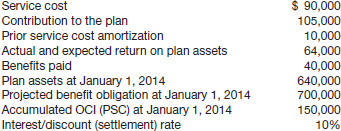
Instructions
Compute the pension expense for the year 2014.
![]()
E20-3 (Preparation of Pension Worksheet) Using the information in E20-2, prepare a pension worksheet inserting January 1, 2014, balances, showing December 31, 2014, balances, and the journal entry recording pension expense.
![]()
E20-4 (Basic Pension Worksheet) The following facts apply to the pension plan of Boudreau Inc. for the year 2014.

Instructions
Using the preceding data, compute pension expense for the year 2014. As part of your solution, prepare a pension worksheet that shows the journal entry for pension expense for 2014 and the year-end balances in the related pension accounts.
![]()
E20-5 (Application of Years-of-Service Method) Andrews Company has five employees participating in its defined benefit pension plan. Expected years of future service for these employees at the beginning of 2014 are as follows.

On January 1, 2014, the company amended its pension plan, increasing its projected benefit obligation by $72,000.
Instructions
Compute the amount of prior service cost amortization for the years 2014 through 2019 using the years-of-service method, setting up appropriate schedules.
![]()
E20-6 (Computation of Actual Return) Gingrich Importers provides the following pension plan information.

From the data above, compute the actual return on the plan assets for 2014.
![]()
![]()

E20-7 (Basic Pension Worksheet) The following defined pension data of Rydell Corp. apply to the year 2014.

Instructions
For 2014, prepare a pension worksheet for Rydell Corp. that shows the journal entry for pension expense and the year-end balances in the related pension accounts.
![]()
E20-8 (Application of the Corridor Approach) Kenseth Corp. has the following beginning-of-the-year present values for its projected benefit obligation and market-related values for its pension plan assets.
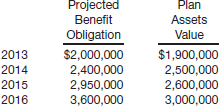
The average remaining service life per employee in 2013 and 2014 is 10 years and in 2015 and 2016 is 12 years. The net gain or loss that occurred during each year is as follows: 2013, $280,000 loss; 2014, $90,000 loss; 2015, $11,000 loss; and 2016, $25,000 gain. (In working the solution, the gains and losses must be aggregated to arrive at year-end balances.)
Instructions
Using the corridor approach, compute the amount of net gain or loss amortized and charged to pension expense in each of the four years, setting up an appropriate schedule.
![]()
E20-9 (Disclosures: Pension Expense and Other Comprehensive Income) Taveras Enterprises provides the following information relative to its defined benefit pension plan.
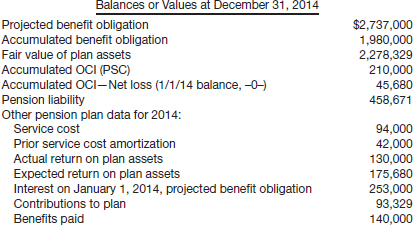
Instructions
(a) Prepare the note disclosing the components of pension expense for the year 2014.
(b) Determine the amounts of other comprehensive income and comprehensive income for 2014. Net income for 2014 is $35,000.
(c) Compute the amount of accumulated other comprehensive income reported at December 31, 2014.
![]()
E20-10 (Pension Worksheet) Webb Corp. sponsors a defined benefit pension plan for its employees. On January 1, 2014, the following balances relate to this plan.
As a result of the operation of the plan during 2014, the following additional data are provided by the actuary.

Instructions
(a) Using the data above, compute pension expense for Webb Corp. for the year 2014 by preparing a pension worksheet.
(b) Prepare the journal entry for pension expense for 2014.
![]()
![]()
E20-11 (Pension Expense, Journal Entries, Statement Presentation) Henning Company sponsors a defined benefit pension plan for its employees. The following data relate to the operation of the plan for the year 2014 in which no benefits were paid.
- The actuarial present value of future benefits earned by employees for services rendered in 2014 amounted to $56,000.
- The company's funding policy requires a contribution to the pension trustee amounting to $145,000 for 2014.
- As of January 1, 2014, the company had a projected benefit obligation of $900,000, an accumulated benefit obligation of $800,000, and a debit balance of $400,000 in accumulated OCI (PSC). The fair value of pension plan assets amounted to $600,000 at the beginning of the year. The actual and expected return on plan assets was $54,000. The settlement rate was 9%. No gains or losses occurred in 2014 and no benefits were paid.
- Amortization of prior service cost was $50,000 in 2014. Amortization of net gain or loss was not required in 2014.
Instructions
(a) Determine the amounts of the components of pension expense that should be recognized by the company in 2014.
(b) Prepare the journal entry or entries to record pension expense and the employer's contribution to the pension trustee in 2014.
(c) Indicate the amounts that would be reported on the income statement and the balance sheet for the year 2014.
![]()
![]()
![]()
![]()
![]()
E20-12 (Pension Expense, Journal Entries, Statement Presentation) Ferreri Company received the following selected information from its pension plan trustee concerning the operation of the company's defined benefit pension plan for the year ended December 31, 2014.

The service cost component of pension expense for employee services rendered in the current year amounted to $77,000 and the amortization of prior service cost was $120,000. The company's actual funding (contributions) of the plan in 2014 amounted to $250,000. The expected return on plan assets and the actual rate were both 10%; the interest/discount (settlement) rate was 10%. Accumulated other comprehensive income (PSC) had a balance of $1,200,000 on January 1, 2014. Assume no benefits paid in 2014.
Instructions
(a) Determine the amounts of the components of pension expense that should be recognized by the company in 2014.
(b) Prepare the journal entry to record pension expense and the employer's contribution to the pension plan in 2014.
(c) Indicate the pension-related amounts that would be reported on the income statement and the balance sheet for Ferreri Company for the year 2014.
![]()
![]()
![]()
![]()
![]()
E20-13 (Computation of Actual Return, Gains and Losses, Corridor Test, and Pension Expense) Erickson Company sponsors a defined benefit pension plan. The corporation's actuary provides the following information about the plan.

Instructions
(a) Compute the actual return on the plan assets in 2014.
(b) Compute the amount of the other comprehensive income (G/L) as of December 31, 2014. (Assume the January 1, 2014, balance was zero.)
(c) Compute the amount of net gain or loss amortization for 2014 (corridor approach).
(d) Compute pension expense for 2014.
![]()
E20-14 (Worksheet for E20-13) Using the information in E20-13 about Erickson Company's defined benefit pension plan, prepare a 2014 pension worksheet with supplementary schedules of computations. Prepare the journal entries at December 31, 2014, to record pension expense and related pension transactions. Also, indicate the pension amounts reported in the balance sheet.
![]()
E20-15 (Pension Expense, Journal Entries) Latoya Company provides the following selected information related to its defined benefit pension plan for 2014.

Instructions
(a) Compute pension expense and prepare the journal entry to record pension expense and the employer's contribution to the pension plan in 2014. Preparation of a pension worksheet is not required. Benefits paid in 2014 were $35,000.
(b) Indicate the pension-related amounts that would be reported in the company's income statement and balance sheet for 2014.
![]()
E20-16 (Amortization of Accumulated OCI (G/L), Corridor Approach, Pension Expense Computation) The actuary for the pension plan of Gustafson Inc. calculated the following net gains and losses.

Other information about the company's pension obligation and plan assets is as follows.

Gustafson Inc. has a stable labor force of 400 employees who are expected to receive benefits under the plan. The total service-years for all participating employees is 5,600. The beginning balance of accumulated OCI (G/L) is zero on January 1, 2014. The market-related value and the fair value of plan assets are the same for the 4-year period. Use the average remaining service life per employee as the basis for amortization.
Instructions
(Round to the nearest dollar.)
Prepare a schedule which reflects the minimum amount of accumulated OCI (G/L) amortized as a component of net periodic pension expense for each of the years 2014, 2015, 2016, and 2017. Apply the “corridor” approach in determining the amount to be amortized each year.
![]()
E20-17 (Amortization of Accumulated OCI Balances) Keeton Company sponsors a defined benefit pension plan for its 600 employees. The company's actuary provided the following information about the plan.

The average remaining service life per employee is 10.5 years. The service cost component of net periodic pension expense for employee services rendered amounted to $400,000 in 2014 and $475,000 in 2015. The accumulated OCI (PSC) on January 1, 2014, was $1,260,000. No benefits have been paid.
Instructions
(Round to the nearest dollar.)
(a) Compute the amount of accumulated OCI (PSC) to be amortized as a component of net periodic pension expense for each of the years 2014 and 2015.
(b) Prepare a schedule which reflects the amount of accumulated OCI (G/L) to be amortized as a component of pension expense for 2014 and 2015.
(c) Determine the total amount of pension expense to be recognized by Keeton Company in 2014 and 2015.
![]()
![]()
E20-18 (Pension Worksheet—Missing Amounts) The accounting staff of Usher Inc. has prepared the following pension worksheet. Unfortunately, several entries in the worksheet are not decipherable. The company has asked your assistance in completing the worksheet and completing the accounting tasks related to the pension plan for 2014.

(a) Determine the missing amounts in the 2014 pension worksheet, indicating whether the amounts are debits or credits.
(b) Prepare the journal entry to record 2014 pension expense for Usher Inc.
(c) The accounting staff has heard of a pension accounting procedure called “corridor amortization.” Is Usher required to record any amounts for corridor amortization in (1) 2014? In (2) 2015? Explain.
![]()
![]()
*E20-19 (Postretirement Benefit Expense Computation) Kreter Co. provides the following information about its postretirement benefit plan for the year 2014.
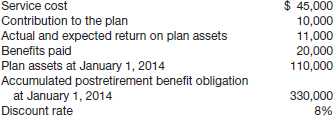
Instructions
Compute the postretirement benefit expense for 2014.
![]()
![]()
*E20-20 (Postretirement Benefit Worksheet) Using the information in E20-19, prepare a worksheet inserting January 1, 2014, balances, and showing December 31, 2014, balances. Prepare the journal entry recording postretirement benefit expense.
![]()
![]()
*E20-21 (Postretirement Benefit Expense Computation) Garner Inc. provides the following information related to its postretirement benefits for the year 2014.

Instructions
Compute postretirement benefit expense for 2014.
![]()
![]()
*E20-22 (Postretirement Benefit Expense Computation) Englehart Co. provides the following information about its postretirement benefit plan for the year 2014.

Instructions
Compute the postretirement benefit expense for 2014.
![]()
![]()
*E20-23 (Postretirement Benefit Worksheet) Using the information in E20-22, prepare a worksheet inserting January 1, 2014, balances, showing December 31, 2014, balances, and the journal entry recording postretirement benefit expense.
![]()
![]()
*E20-24 (Postretirement Benefit Worksheet—Missing Amounts) The accounting staff of Holder Inc. has prepared the following postretirement benefit worksheet. Unfortunately, several entries in the worksheet are not decipherable. The company has asked your assistance in completing the worksheet and completing the accounting tasks related to the pension plan for 2014.
Instructions
(a) Determine the missing amounts in the 2014 postretirement worksheet, indicating whether the amounts are debits or credits.
(b) Prepare the journal entry to record 2014 postretirement expense for Holder Inc.
(c) What discount rate is Holder using in accounting for the interest on its other postretirement benefit plan? Explain.
EXERCISES SET B
See the book's companion website, at www.wiley.com/college/kieso, for an additional set of exercises.
PROBLEMS
![]()
![]()
![]()
![]()

P20-1 (2-Year Worksheet) On January 1, 2014, Harrington Company has the following defined benefit pension plan balances.
![]()
The interest (settlement) rate applicable to the plan is 10%. On January 1, 2015, the company amends its pension agreement so that prior service costs of $500,000 are created. Other data related to the pension plan are as follows.

(a) Prepare a pension worksheet for the pension plan for 2014 and 2015.
(b) For 2015, prepare the journal entry to record pension-related amounts.
![]()
![]()
![]()
![]()
![]()
P20-2 (3-Year Worksheet, Journal Entries, and Reporting) Jackson Company adopts acceptable accounting for its defined benefit pension plan on January 1, 2013, with the following beginning balances: plan assets $200,000; projected benefit obligation $250,000. Other data relating to 3 years' operation of the plan are as follows.

Instructions
(a) Prepare a pension worksheet presenting all 3 years' pension balances and activities.
(b) Prepare the journal entries (from the worksheet) to reflect all pension plan transactions and events at December 31 of each year.
(c) Indicate the pension-related amounts reported in the financial statements for 2015.
![]()
![]()
![]()
![]()
P20-3 (Pension Expense, Journal Entries, Amortization of Loss) Gottschalk Company sponsors a defined benefit plan for its 100 employees. On January 1, 2014, the company's actuary provided the following information.

The average remaining service period for the participating employees is 10 years. All employees are expected to receive benefits under the plan. On December 31, 2014, the actuary calculated that the present value of future benefits earned for employee services rendered in the current year amounted to $52,000; the projected benefit obligation was $490,000; fair value of pension assets was $276,000; the accumulated benefit obligation amounted to $365,000. The expected return on plan assets and the discount rate on the projected benefit obligation were both 10%. The actual return on plan assets is $11,000. The company's current year's contribution to the pension plan amounted to $65,000. No benefits were paid during the year.
Instructions
(a) Determine the components of pension expense that the company would recognize in 2014. (With only one year involved, you need not prepare a worksheet.)
(b) Prepare the journal entry to record the pension expense and the company's funding of the pension plan in 2014.
(c) Compute the amount of the 2014 increase/decrease in gains or losses and the amount to be amortized in 2014 and 2015.
(d) Indicate the pension amounts reported in the financial statement as of December 31, 2014.
![]()
![]()
![]()
![]()

P20-4 (Pension Expense, Journal Entries for 2 Years) Gordon Company sponsors a defined benefit pension plan. The following information related to the pension plan is available for 2014 and 2015.

(a) Compute pension expense for 2014 and 2015.
(b) Prepare the journal entries to record the pension expense and the company's funding of the pension plan for both years.
![]()
![]()
P20-5 (Computation of Pension Expense, Amortization of Net Gain or Loss–Corridor Approach, Journal Entries for 3 Years) Hiatt Toothpaste Company initiates a defined benefit pension plan for its 50 employees on January 1, 2014. The insurance company which administers the pension plan provided the following selected information for the years 2014, 2015, and 2016.

There were no balances as of January 1, 2014, when the plan was initiated. The actual and expected return on plan assets was 10% over the 3-year period, but the settlement rate used to discount the company's pension obligation was 13% in 2014, 11% in 2015, and 8% in 2016. The service cost component of net periodic pension expense amounted to the following: 2014, $60,000; 2015, $85,000; and 2016, $119,000. The average remaining service life per employee is 12 years. No benefits were paid in 2014, $30,000 of benefits were paid in 2015, and $18,500 of benefits were paid in 2016 (all benefits paid at end of year).
Instructions
(Round to the nearest dollar.)
(a) Calculate the amount of net periodic pension expense that the company would recognize in 2014, 2015, and 2016.
(b) Prepare the journal entries to record net periodic pension expense, employer's funding contribution, and related pension amounts for the years 2014, 2015, and 2016.
![]()
![]()
![]()
P20-6 (Computation of Prior Service Cost Amortization, Pension Expense, Journal Entries, and Net Gain or Loss) Aykroyd Inc. has sponsored a noncontributory, defined benefit pension plan for its employees since 1991. Prior to 2014, cumulative net pension expense recognized equaled cumulative contributions to the plan. Other relevant information about the pension plan on January 1, 2014, is as follows.
- The company has 200 employees. All these employees are expected to receive benefits under the plan. The average remaining service life per employee is 12 years.
- The projected benefit obligation amounted to $5,000,000 and the fair value of pension plan assets was $3,000,000. The market-related asset value was also $3,000,000. Unrecognized prior service cost was $2,000,000.
On December 31, 2014, the projected benefit obligation and the accumulated benefit obligation were $4,850,000 and $4,025,000, respectively. The fair value of the pension plan assets amounted to $4,100,000 at the end of the year. A 10% settlement rate and a 10% expected asset return rate were used in the actuarial present value computations in the pension plan. The present value of benefits attributed by the pension benefit formula to employee service in 2014 amounted to $200,000. The employer's contribution to the plan assets amounted to $775,000 in 2014. This problem assumes no payment of pension benefits.
![]()
Instructions
(Round all amounts to the nearest dollar.)
(a) Prepare a schedule, based on the average remaining life per employee, showing the prior service cost that would be amortized as a component of pension expense for 2014, 2015, and 2016.
(b) Compute pension expense for the year 2014.
(c) Prepare the journal entries required to report the accounting for the company's pension plan for 2014.
(d) Compute the amount of the 2014 increase/decrease in net gains or losses and the amount to be amortized in 2014 and 2015.
![]()
![]()
![]()
P20-7 (Pension Worksheet) Hanson Corp. sponsors a defined benefit pension plan for its employees. On January 1, 2014, the following balances related to this plan.

As a result of the operation of the plan during 2014, the actuary provided the following additional data for 2014.

Instructions
Using the preceding data, compute pension expense for Hanson Corp. for the year 2014 by preparing a pension worksheet that shows the journal entry for pension expense. Use the market-related asset value to compute the expected return and for corridor amortization.
![]()
![]()
![]()
![]()
![]()
![]()
P20-8 (Comprehensive 2-Year Worksheet) Lemke Company sponsors a defined benefit pension plan for its employees. The following data relate to the operation of the plan for the years 2014 and 2015.
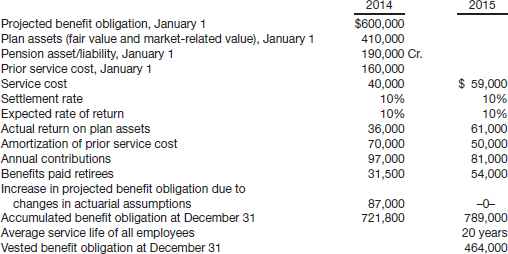
Instructions
(a) Prepare a pension worksheet presenting both years 2014 and 2015 and accompanying computations and amortization of the loss (2015) using the corridor approach.
(b) Prepare the journal entries (from the worksheet) to reflect all pension plan transactions and events at December 31 of each year.
(c) For 2015, indicate the pension amounts reported in the financial statements.
![]()
![]()
![]()
![]()
P20-9 (Comprehensive 2-Year Worksheet) Hobbs Co. has the following defined benefit pension plan balances on January 1, 2014.
![]()
The interest (settlement) rate applicable to the plan is 10%. On January 1, 2015, the company amends its pension agreement so that prior service costs of $600,000 are created. Other data related to the pension plan are:

Instructions
(a) Prepare a pension worksheet for the pension plan in 2014.
(b) Prepare any journal entries related to the pension plan that would be needed at December 31, 2014.
(c) Prepare a pension worksheet for 2015 and any journal entries related to the pension plan as of December 31, 2015.
(d) Indicate the pension-related amounts reported in the 2015 financial statements.
![]()
P20-10 (Pension Worksheet—Missing Amounts) Kramer Co. has prepared the following pension worksheet. Unfortunately, several entries in the worksheet are not decipherable. The company has asked your assistance in completing the worksheet and completing the accounting tasks related to the pension plan for 2014.

Instructions
(a) Determine the missing amounts in the 2014 pension worksheet, indicating whether the amounts are debits or credits.
(b) Prepare the journal entry to record 2014 pension expense for Kramer Co.
(c) Determine the following for Kramer for 2014: (1) settlement rate used to measure the interest on the liability and (2) expected return on plan assets.
![]()
![]()
![]()
![]()
![]()
P20-11 (Pension Worksheet) The following data relate to the operation of Kramer Co.'s pension plan in 2015. The pension worksheet for 2014 is provided in P20-10.

For 2015, Kramer will use the same assumptions as 2014 for the expected rate of returns on plan assets. The settlement rate for 2015 is 10%.
Instructions
(a) Prepare a pension worksheet for 2015 and accompanying computations and amortization of the loss, if any, in 2015 using the corridor approach.
(b) Prepare the journal entries (from the worksheet) to reflect all pension plan transactions and events at December 31.
(c) Indicate the pension amounts reported in the financial statements.
![]()
![]()
![]()
![]()
![]()
P20-12 (Pension Worksheet) Larson Corp. sponsors a defined benefit pension plan for its employees. On January 1, 2015, the following balances related to this plan.

As a result of the operation of the plan during 2015, the actuary provided the following additional data for 2015.

Instructions
(a) Compute pension expense for Larson Corp. for the year 2015 by preparing a pension worksheet that shows the journal entry for pension expense.
(b) Indicate the pension amounts reported in the financial statements.
![]()
![]()
![]()
*P20-13 (Postretirement Benefit Worksheet) Hollenbeck Foods Inc. sponsors a postretirement medical and dental benefit plan for its employees. The following balances relate to this plan on January 1, 2014.

As a result of the plan's operation during 2014, the following additional data are provided by the actuary.
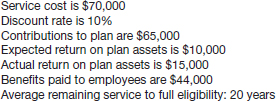
Instructions
(a) Using the preceding data, compute the net periodic postretirement benefit cost for 2014 by preparing a worksheet that shows the journal entry for postretirement expense and the year-end balances in the related postretirement benefit memo accounts. (Assume that contributions and benefits are paid at the end of the year.)
(b) Prepare any journal entries related to the postretirement plan for 2014 and indicate the postretirement amounts reported in the financial statements for 2014.
![]()
![]()
*P20-14 (Postretirement Benefit Worksheet—2 Years) Elton Co. has the following postretirement benefit plan balances on January 1, 2014.
![]()
The interest (settlement) rate applicable to the plan is 10%. On January 1, 2015, the company amends the plan so that prior service costs of $175,000 are created. Other data related to the plan are:

Instructions
(a) Prepare a worksheet for the postretirement plan in 2014.
(b) Prepare any journal entries related to the postretirement plan that would be needed at December 31, 2014.
(c) Prepare a worksheet for 2015 and any journal entries related to the postretirement plan as of December 31, 2015.
(d) Indicate the postretirement-benefit–related amounts reported in the 2015 financial statements.
PROBLEMS SET B
See the book's companion website, at www.wiley.com/college/kieso, for an additional set of problems.
CONCEPTS FOR ANALYSIS
CA20-1 (Pension Terminology and Theory) Many business organizations have been concerned with providing for the retirement of employees since the late 1800s. During recent decades, a marked increase in this concern has resulted in the establishment of private pension plans in most large companies and in many medium- and small-sized ones.
The substantial growth of these plans, both in numbers of employees covered and in amounts of retirement benefits, has increased the significance of pension costs in relation to the financial position, results of operations, and cash flows of many companies. In examining the costs of pension plans, a CPA encounters certain terms. The components of pension costs that the terms represent must be dealt with appropriately if generally accepted accounting principles are to be reflected in the financial statements of entities with pension plans.
Instructions
(a) Define a private pension plan. How does a contributory pension plan differ from a noncontributory plan?
(b) Differentiate between “accounting for the employer” and “accounting for the pension fund.”
(c) Explain the terms “funded” and “pension liability” as they relate to:
(1) The pension fund.
(2) The employer.
(d)
(1) Discuss the theoretical justification for accrual recognition of pension costs.
(2) Discuss the relative objectivity of the measurement process of accrual versus cash (pay-as-you-go) accounting for annual pension costs.
(e) Distinguish among the following as they relate to pension plans.
(1) Service cost.
(2) Prior service costs.
(3) Vested benefits.
![]()
CA20-2 (Pension Terminology) The following items appear on Brueggen Company's financial statements.
- Under the caption Assets:
Pension asset/liability. - Under the caption Liabilities:
Pension asset/liability. - Under the caption Stockholders' Equity:
Prior service cost as a component of Accumulated Other Comprehensive Income. - On the income statement:
Pension expense.
Instructions
Explain the significance of each of the items above on corporate financial statements. (Note: All items set forth above are not necessarily to be found on the statements of a single company.)
CA20-3 (Basic Terminology) In examining the costs of pension plans, Helen Kaufman, CPA, encounters certain terms. The components of pension costs that the terms represent must be dealt with appropriately if generally accepted accounting principles are to be reflected in the financial statements of entities with pension plans.
Instructions
(a)
(1) Discuss the theoretical justification for accrual recognition of pension costs.
(2) Discuss the relative objectivity of the measurement process of accrual versus cash (pay-as-you-go) accounting for annual pension costs.
(b) Explain the following terms as they apply to accounting for pension plans.
(1) Market-related asset value.
(2) Projected benefit obligation.
(3) Corridor approach.
(c) What information should be disclosed about a company's pension plans in its financial statements and its notes?
(AICPA adapted)
![]()
CA20-4 (Major Pension Concepts) Davis Corporation is a medium-sized manufacturer of paperboard containers and boxes. The corporation sponsors a noncontributory, defined benefit pension plan that covers its 250 employees. Sid Cole has recently been hired as president of Davis Corporation. While reviewing last year's financial statements with Carol Dilbeck, controller, Cole expressed confusion about several of the items in the footnote to the financial statements relating to the pension plan. In part, the footnote reads as follows.
Note J. The company has a defined benefit pension plan covering substantially all of its employees. The benefits are based on years of service and the employee's compensation during the last four years of employment. The company's funding policy is to contribute annually the maximum amount allowed under the federal tax code. Contributions are intended to provide for benefits expected to be earned in the future as well as those earned to date.
The net periodic pension expense on Davis Corporation's comparative income statement was $72,000 in 2014 and $57,680 in 2013.
The following are selected figures from the plan's funded status and amounts recognized in the Davis Corporation's Statement of Financial Position at December 31, 2014 ($000 omitted).
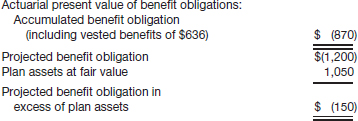
Given that Davis Corporation's work force has been stable for the last 6 years, Cole could not understand the increase in the net periodic pension expense. Dilbeck explained that the net periodic pension expense consists of several elements, some of which may increase or decrease the net expense.
Instructions
(a) The determination of the net periodic pension expense is a function of five elements. List and briefly describe each of the elements.
(b) Describe the major difference and the major similarity between the accumulated benefit obligation and the projected benefit obligation.
(c)
(1) Explain why pension gains and losses are not recognized on the income statement in the period in which they arise.
(2) Briefly describe how pension gains and losses are recognized.
(CMA adapted)
![]()
CA20-5 (Implications of GAAP Rules on Pensions) Jill Vogel and Pete Dell have to do a class presentation on GAAP rules for reporting pension information. In developing the class presentation, they decided to provide the class with a series of questions related to pensions and then discuss the answers in class. Given that the class has all read the rules related to pension accounting and reporting, they felt this approach would provide a lively discussion. Here are the questions:
- In an article in BusinessWeek prior to new rules related to pensions, it was reported that the discount rates used by the largest 200 companies for pension reporting ranged from 5% to 11%. How can such a situation exist, and does GAAP alleviate this problem?
- An article indicated that when new GAAP rules were issued related to pensions, it caused an increase in the liability for pensions for approximately 20% of companies. Why might this situation occur?
- A recent article noted that while “smoothing” is not necessarily an accounting virtue, pension accounting has long been recognized as an exception—an area of accounting in which at least some dampening of market swings is appropriate. This is because pension funds are managed so that their performance is insulated from the extremes of short-term market swings. A pension expense that reflects the volatility of market swings might, for that reason, convey information of little relevance. Are these statements true?
- Understanding the impact of the changes required in pension reporting requires detailed information about its pension plan(s) and an analysis of the relationship of many factors, particularly the:
(a) Type of plan(s) and any significant amendments.
(b) Plan participants.
(c) Funding status.
(d) Actuarial funding method and assumptions currently used.
What impact does each of these items have on financial statement presentation?
- An article noted “You also need to decide whether to amortize gains and losses using the corridor method, or to use some other systematic method. Under the corridor approach, only gains and losses in excess of 10% of the greater of the projected benefit obligation or the plan assets would have to be amortized.” What is the corridor method and what is its purpose?
Instructions
What answers do you believe Jill and Pete gave to each of these questions?
![]()
CA20-6 (Gains and Losses, Corridor Amortization) Vickie Plato, accounting clerk in the personnel office of Streisand Corp., has begun to compute pension expense for 2016 but is not sure whether or not she should include the amortization of unrecognized gains/losses. She is currently working with the following beginning-of-the-year present values for the projected benefit obligation and market-related values for the pension plan:

The average remaining service life per employee in 2013 and 2014 is 10 years and in 2015 and 2016 is 12 years. The net gain or loss that occurred during each year is as follows.

(In working the solution, you must aggregate the unrecognized gains and losses to arrive at year-end balances.)
Instructions
You are the manager in charge of accounting. Write a memo to Vickie Plato, explaining why in some years she must amortize some of the net gains and losses and in other years she does not need to. In order to explain this situation fully, you must compute the amount of net gain or loss that is amortized and charged to pension expense in each of the 4 years listed above. Include an appropriate amortization schedule, referring to it whenever necessary.
![]()
CA20-7 (Nonvested Employees—An Ethical Dilemma) Thinken Technology recently merged with College Electronix (CE), a computer graphics manufacturing firm. In performing a comprehensive audit of CE's accounting system, Gerald Ott, internal audit manager for Thinken Technology, discovered that the new subsidiary did not record pension assets and liabilities, subject to GAAP.
The net present value of CE's pension assets was $15.5 million, the vested benefit obligation was $12.9 million, and the projected benefit obligation was $17.4 million. Ott reported this audit finding to Julie Habbe, the newly appointed controller of CE. A few days later, Habbe called Ott for his advice on what to do. Habbe started her conversation by asking, “Can't we eliminate the negative income effect of our pension dilemma simply by terminating the employment of nonvested employees before the end of our fiscal year?”
Instructions
How should Ott respond to Habbe's remark about firing nonvested employees?
USING YOUR JUDGMENT
Financial Reporting Problem
The Procter & Gamble Company (P&G)
![]()
The financial statements of P&G are presented in Appendix 5B. The company's complete annual report, including the notes to the financial statements, can be accessed at the book's companion website, www.wiley.com/college/kieso.
Instructions
Refer to P&G's financial statements and the accompanying notes to answer the following questions.
(a) What kind of pension plan does P&G provide its employees in the United States?
(b) What was P&G's pension expense for 2011, 2010, and 2009 for the United States?
(c) What is the impact of P&G's pension plans for 2011 on its financial statements?
(d) What information does P&G provide on the target allocation of its pension assets? (Compare the asset allocation for “Pensions and Other Retiree Benefits.”) How do the allocations relate to the expected returns on these assets?
Comparative Analysis Case
The Coca-Cola Company and PepsiCo, Inc.
Instructions
Go to the book's companion website and use information found there to answer the following questions related to The Coca-Cola Company and PepsiCo, Inc.
(a) What kind of pension plans do Coca-Cola and PepsiCo provide their employees?
(b) What net periodic pension expense (cost) did Coca-Cola and PepsiCo report in 2011?
(c) What is the year-end 2011 funded status of Coca-Cola's and PepsiCo's U.S. plans?
(d) What relevant rates were used by Coca-Cola and PepsiCo in computing their pension amounts?
(e) Compare the expected benefit payments and contributions for Coca-Cola and PepsiCo.
*Financial Statement Analysis Case
General Electric
A Wall Street Journal article discussed a $1.8 billion charge to income made by General Electric for postretirement benefit costs. It was attributed to previously unrecognized healthcare and life insurance cost. As financial vice president and controller for Peake, Inc., you found this article interesting because the president recently expressed interest in adopting a postemployment benefit program for Peake's employees, to complement the company's existing defined benefit plan. The president, Martha Beyerlein, wants to know how the expense on the new plan will be determined and what impact the accounting for the plan will have on Peake's financial statements.
Instructions
(a) As financial vice president and controller of Peake, Inc., explain the calculation of postemployment benefit expense under GAAP, and indicate how the accounting for the plan will affect Peake's financial statements.
(b) Discuss the similarities and differences in the accounting for the other postemployment benefit plan relative to the accounting for the defined benefit plan.
Accounting, Analysis, and Principles
PENCOMP's balance sheet at December 31, 2014, is as follows.
Accounting
Prepare an income statement for 2015 and a balance sheet as of December 31, 2015. Also, prepare the pension expense journal entry for the year ended December 31, 2015. Round to the nearest tenth (e.g., round 2.87 to 2.9).
Analysis
Compute return on equity for PENCOMP for 2015 (assume stockholders' equity is equal to year-end average stockholders' equity). Do you think an argument can be made for including some or even all of the change in accumulated other comprehensive income (due to pensions) in the numerator of return on equity? Illustrate that calculation.
Principles
Explain a rationale for why the FASB has (so far) decided to exclude from the current period income statement the effects of pension plan amendments and gains and losses due to changes in actuarial assumptions.
![]()
Professional Research: FASB Codification
Monat Company has grown rapidly since its founding in 2004. To instill loyalty in its employees, Monat is contemplating establishment of a defined benefit plan. Monat knows that lenders and potential investors will pay close attention to the impact of the pension plan on the company's financial statements, particularly any gains or losses that develop in the plan. Monat has asked you to conduct some research on the accounting for gains and losses in a defined benefit plan.
Instructions
If your school has a subscription to the FASB Codification, go to http://aaahq.org/ascLogin.cfm to log in and prepare responses to the following. Provide Codification references for your responses.
(a) Briefly describe how pension gains and losses are accounted for.
(b) Explain the rationale behind the accounting method described in part (a).
(c) What is the related pension asset or liability that will show up on the balance sheet? When will each of these situations occur?
Additional Professional Resources
See the book's companion website, at www.wiley.com/college/kieso, for professional simulations as well as other study resources.
 INSIGHTS
INSIGHTS
LEARNING OBJECTIVE ![]()
Compare the accounting for pensions under GAAP and IFRS.
The accounting for various forms of compensation plans under IFRS is found in IAS 19 (“Employee Benefits”) and IFRS 2 (“Share-Based Payment”). IAS 19 addresses the accounting for a wide range of compensation elements—wages, bonuses, postretirement benefits, and compensated absences. The underlying concepts for the accounting for postretirement benefits are similar between GAAP and IFRS—both GAAP and IFRS view pensions and other postretirement benefits as forms of deferred compensation. At present, there are significant differences in the specific accounting provisions as applied to these plans.
RELEVANT FACTS
Following are the key similarities and differences between GAAP and IFRS related to pensions.
Similarities
- IFRS and GAAP separate pension plans into defined contribution plans and defined benefit plans. The accounting for defined contribution plans is similar.
- IFRS and GAAP recognize a pension asset or liability as the funded status of the plan (i.e., defined benefit obligation minus the fair value of plan assets). (Note that defined benefit obligation is referred to as the projected benefit obligation in GAAP.)
- IFRS and GAAP compute unrecognized past service cost (PSC) (referred to as prior service cost in GAAP) in the same manner. However, IFRS recognizes past service cost as a component of pension expense in income immediately. GAAP amortizes PSC over the remaining service lives of employees.
- IFRS and GAAP include interest expense on the liability in pension expense. Regarding asset returns, IFRS reduces pension expense by the amount of interest revenue (based on the discount rate times the beginning value of pension assets). GAAP includes an asset return component based on the expected return on plan assets.
- Under IFRS, companies recognize both liability and asset gains and losses (referred to as remeasurements) in other comprehensive income. These gains and losses are not “recycled” into income in subsequent periods. GAAP recognizes liability and asset gains and losses in “Accumulated other comprehensive income” and amortizes these amounts to income over remaining service lives, using the “corridor approach.”
- The accounting for pensions and other postretirement benefit plans is the same under IFRS. GAAP has separate standards for these types of benefits, and significant differences exist in the accounting.
ABOUT THE NUMBERS
Accounting for Pensions
Net Defined Benefit Obligation (Asset)
As in GAAP, under IFRS the net defined benefit liability (asset) is the deficit or surplus related to a defined benefit pension plan. The deficit or surplus is measured as follows.
![]()
The deficit or surplus is often referred to as the funded status of the plan.
If the defined benefit obligation is greater than the plan assets, the pension plan has a deficit. Conversely, if the defined pension obligation is less than the plan assets, the pension plan has a surplus. Illustration IFRS20-1 shows these relationships.
The net defined benefit obligation (asset) is often referred to simply as the pension liability or the pension asset on the statement of financial position.
As indicated, companies should report either a pension asset or pension liability related to a pension plan on the statement of financial position (often referred to as the net approach). To illustrate, assume that at year-end Acer Company has a defined pension obligation of $4,000,000 and plan assets of $3,700,000. In this case, Acer reports $300,000 ($4,000,000 − $3,700,000) as a pension liability on its statement of financial position.
Some believe that companies should report separately both the defined benefit obligation and the plan assets on the statement of financial position. This approach (often referred to as the gross approach) would report Acer's defined benefit obligation of $4,000,000 and its plan assets of $3,700,000 on the statement of financial position. The IASB disagrees, indicating that offsetting these amounts is consistent with its standard on when assets and liabilities should be netted.28
Reporting Changes in the Defined Benefit Obligation (Asset)
The IASB requires that all changes in the defined benefit obligation and plan assets in the current period be recognized in comprehensive income. The Board believes that immediate recognition of the effects of these changes in the statement of comprehensive income provides the most understandable and useful information to financial statement users. The IASB requires that companies report changes arising from different elements of pension liabilities and assets in different sections of the statement of comprehensive income, depending on their nature.
In the past, companies often reported only a single pension expense number in the comprehensive income statement. Providing additional segmentation of the components of pension cost provides additional transparency about the nature of these costs. The three components are as follows.
- Service cost. Service cost is either current service cost or past service cost. Current service cost is the increase in the present value of the defined benefit obligation from employee service in the current period. Past service cost is the change in the present value of the defined benefit obligation for employee service for prior periods—generally resulting from a plan amendment (e.g., changes to the plan). This component is reported in the statement of comprehensive income in the operating section of the statement and affects net income.
- Net interest. Net interest is computed by multiplying the discount rate by the funded status of the plan (defined benefit obligation minus plan assets). If the plan has a net defined benefit obligation at the end of the period, the company reports interest expense. Conversely, if it has a net defined benefit asset, it reports interest revenue. This approach is justified on the basis of its simplicity and that any financing costs should be based on the funded status of the plan. This amount is often shown below the operating section of the income statement in the financing section and affects net income.
- Remeasurements. Remeasurements are gains and losses related to the defined benefit obligation (changes in discount rate or other actuarial assumptions) and gains or losses on the fair value of the plan assets (actual rate of return less interest revenue included in the finance component). This component is reported in other comprehensive income, net of tax. These remeasurement gains or losses therefore affect comprehensive income but not net income.
Illustration IFRS20-2 shows the components of changes in the pension liability (asset) and their placement on the statement of comprehensive income.
As indicated in Illustration IFRS20-2, service cost and net interest are reported in net income. We discuss determination of each of these components in the following section. Remeasurements, which are reported in other comprehensive income, are discussed in a later section.
Service Cost. To determine current service cost and the related increase in the defined benefit obligation, companies must:
- Apply an actuarial valuation method.
- Assign benefits to period of service.
- Make actuarial assumptions.29
In applying an actuarial valuation method, the IASB concluded that companies must consider future compensation levels in measuring the present obligation and periodic pension expense if the plan benefit formula incorporates them. In other words, the present obligation resulting from a promise to pay a benefit of 1 percent of an employee's final pay differs from the promise to pay 1 percent of current pay. To overlook this fact is to ignore an important aspect of pension expense. Thus, the Board adopts the projected unit credit method (often referred to as the benefits/years-of-service method), which determines pension expense based on future salary levels.
Some object to this determination, arguing that a company should have more freedom to select an expense recognition pattern. Others believe that incorporating future salary increases into current pension expense is accounting for events that have not yet happened. They argue that if a company terminates the plan today, it pays only liabilities for accumulated benefits. Nevertheless, the IASB indicates that the defined benefit obligation provides a more realistic measure of the employer's obligation under the plan on a going concern basis and, therefore, companies should use it as the basis for determining service cost.
The assignment of benefits to periods of service is based on the actuarial valuation method. The actuary then allocates the cost of the pension benefits over the expected service life of the company's employees. In determining the proper service cost for a period, the actuary makes actuarial assumptions related to such factors as mortality; rates of employee turnover, disability, and early retirement; discount rate; benefit levels; and future salary levels. While IAS 19 does not require use of an actuary, given the complexity of these estimates, just about all companies rely on an actuary to determine service cost and related other defined benefit measures.
Net Interest. In computing net interest, companies assume that the discount rate, the net defined benefit obligation, and the pension asset are determined at the beginning of the year.30 The discount rate is based on the yields of high-quality bonds with terms consistent with the company's pension obligation. Net interest is then computed as indicated in the following equation.
![]()
That is, net interest is determined by multiplying the net defined pension obligation (asset) by the discount rate.
Because payment of the pension obligation is deferred, companies record the pension liability on a discounted basis. As a result, the liability accrues interest over the service life of the employee (passage of time), which is essentially interest expense (interest on the liability). Similarly, companies earn a return on their plan assets. That is, a company assumes that it earns interest based on multiplying the discount rate by the plan assets. While the IASB recognizes that the actual return on plan assets may differ from the assumed interest revenue computed, it believes that the change in plan assets can be divided into an amount that arises from the passage of time and amounts that arise from other changes. As we discuss in the next section, changes not related to the passage of time are reported in other comprehensive income as remeasurements. Thus, the growth in the plan assets should mirror the growth in the defined benefit obligation. In other words, the assumed interest revenue on the plan assets based on the passage of time offsets the interest expense on the defined benefit obligation.
In summary, pension expense is comprised of two components: (1) service cost and (2) net interest. Companies report each of these components in the statement of comprehensive income. In some cases, companies may choose to report these components in one section of the statement of comprehensive income and report total pension expense. Other companies may choose to report the service cost component in operating income and the net interest in a separate section related to financing.31
Plan Assets and Actual Return
Pension plan assets are usually investments in shares, bonds, other securities, and real estate that a company holds to earn a reasonable rate of return. Plan assets are reported at fair value. Companies generally hold these assets in a separate legal entity (a pension fund) that exists only to administer the employee benefit plan. These assets held by the pension fund are therefore not available to the company's own creditors (even in bankruptcy). Employer contributions and the actual return on plan assets increase pension plan assets. Actual return on plan assets is the increase in the pension fund assets arising from interest, dividends, and realized and unrealized changes in the fair value of the plan. Benefits paid to retired employees decrease plan assets.
To illustrate, assume that Hasbro Company has pension plan assets of $4,200,000 on January 1, 2014. During 2014, Hasbro contributed $300,000 to the plan and paid out retirement benefits of $250,000. Its actual return on plan assets was $210,000 for the year. Hasbro's plan assets at December 31, 2014, are $4,460,000, computed as shown in Illustration IFRS20-3.
In some cases, companies compute the actual return by adjusting the change in plan assets for the effect of contributions during the year and benefits paid during the year. The equation in Illustration IFRS20-4, or a variation thereof, can be used to compute the actual return.
Stated another way, the actual return on plan assets is the difference between the fair value of the plan assets at the beginning of the period and at the end of the period, adjusted for contributions and benefit payments. Illustration IFRS20-5 uses the equation above to compute actual return, using the information provided in Illustration IFRS20-3.
In this case, Hasbro has a positive actual return on plan assets. Recently, some pension plans have experienced negative actual returns due to the increased volatility in global securities markets.
Using a Pension Worksheet
We will now illustrate the basic computation of pension expense using the first two components: (1) service cost and (2) net interest. We discuss remeasurements in later sections.
Companies often use a worksheet to record pension-related information. As its name suggests, the worksheet is a working tool. A worksheet is not a permanent accounting record: It is neither a journal nor part of the general ledger. The worksheet is merely a device to make it easier to prepare entries and the financial statements.32 Illustration IFRS20-6 shows the format of the pension worksheet.
The “General Journal Entries” columns of the worksheet (near the left side) determine the entries to record in the formal general ledger accounts. The “Memo Record” columns (on the right side) maintain balances in the defined benefit obligation and the plan assets. The difference between the defined benefit obligation and the fair value of the plan assets is the pension asset/liability, which is shown in the statement of financial position. If the defined benefit obligation is greater than the plan assets, a pension liability occurs. If the defined benefit obligation is less than the plan assets, a pension asset occurs.
On the first line of the worksheet, a company enters the beginning balances (if any). It then records subsequent transactions and events related to the pension plan using debits and credits, using both sets of columns as if they were one. For each transaction or event, the debits must equal the credits. The ending balance in the Pension Asset/Liability column should equal the net balance in the memo record.
2014 Entries and Worksheet
To illustrate the use of a worksheet and how it helps in accounting for a pension plan, assume that on January 1, 2014, Zarle Company provides the following information related to its pension plan for the year 2014.
Plan assets, January 1, 2014, are $100,000.
Defined benefit obligation, January 1, 2014, is $100,000.
Annual service cost is $9,000.
Discount rate is 10 percent.
Funding contributions are $8,000.
Benefits paid to retirees during the year are $7,000.
Using the data presented above, the worksheet in Illustration IFRS20-7 presents the beginning balances and all of the pension entries recorded by Zarle in 2014. Zarle records the beginning balances for the defined benefit obligation and the pension plan assets on the first line of the worksheet in the memo record. Because the defined benefit obligation and the plan assets are the same at January 1, 2014, the Pension Asset/Liability account has a zero balance at January 1, 2014.
Entry (a) in Illustration IFRS20-7 records the service cost component, which increases pension expense by $9,000 and increases the liability (defined benefit obligation) by $9,000. Entry (b) accrues the interest expense component, which increases both the liability and the pension expense by $10,000 (the beginning defined benefit obligation multiplied by the discount rate of 10 percent). Entry (c) records the interest revenue component, which increases plan assets and decreases pension expense by $10,000. This is computed by multiplying the beginning plan assets by the discount rate of 10 percent. As a result, net interest expense (income) is zero in 2014. Entry (d) records Zarle's contribution (funding) of assets to the pension fund, thereby decreasing cash by $8,000 and increasing plan assets by $8,000. Entry (e) records the benefit payments made to retirees, which results in equal $7,000 decreases to the plan assets and the defined benefit obligation.
Zarle makes the “formal journal entry” on December 31, which records the pension expense in 2014, as follows.

The credit to Pension Asset/Liability for $1,000 represents the difference between the 2014 pension expense of $9,000 and the amount funded of $8,000. Pension Asset/Liability (credit) is a liability because Zarle underfunds the plan by $1,000. The Pension Asset/Liability account balance of $1,000 also equals the net of the balances in the memo accounts. Illustration IFRS20-8 shows that the defined benefit obligation exceeds the plan assets by $1,000, which reconciles to the pension liability reported in the statement of financial position.
If the net of the memo record balances is a credit, the reconciling amount in the Pension Asset/Liability column will be a credit equal in amount. If the net of the memo record balances is a debit, the Pension Asset/Liability amount will be a debit equal in amount. The worksheet is designed to produce this reconciling feature, which is useful later in the preparation of the financial statements and required note disclosure related to pensions.
In this illustration (for 2014), the debit to Pension Expense exceeds the credit to Cash, resulting in a credit to Pension Asset/Liability—the recognition of a liability. If the credit to Cash exceeded the debit to Pension Expense, Zarle would debit Pension Asset/Liability—the recognition of an asset.33
Past Service Cost
Past service cost is the change in the present value of the defined benefit obligation resulting from a plan amendment or a curtailment.34 For example, a plan amendment arises when a company decides to provide additional benefits to existing employees for past service. Conversely, the company may decide that it is necessary to reduce its benefit package retroactively for existing employees, thereby reducing their pension benefit. A curtailment occurs when the company has a significant reduction in the number of employees covered by the plan. Because a curtailment has the same effect as a reduction in benefits due to an amendment to the plan, these situations are accounted for in the same way. Illustration IFRS20-9 summarizes the nature of past service costs.
The accounting for past service cost is straightforward—expense past service cost in the period of the amendment or curtailment. As a result, a substantial increase (decrease) in pension expense and the defined benefit obligation often results when a plan amendment or curtailment occurs. Because current and past service costs relate directly to employment, they are reported in the operating section of the statement of comprehensive income.
Some disagree with the IASB position of expensing these costs in the year a plan is amended or curtailed. They argue that a company would not provide these additional benefits for past years of service unless it expects to receive benefits in the future. According to this reasoning, a company should not recognize the full past service cost in the year of the amendment. Instead, the past service cost should be spread out over the remaining service life of employees who are expected to benefit from the changes in the plan. Others believe that if they are truly past service costs, they should be treated retroactively as an adjustment made to prior periods.
However, the IASB decided that any changes in the defined benefit obligation or plan assets should be recognized in the current period. To do otherwise is not informative and leads to delayed recognition of costs or reduced benefits which are neither assets nor liabilities.
It is also possible to decrease past service costs by decreasing the defined benefit obligation (referred to as negative past service cost). Negative past service cost arises when an entity changes the benefits attributable to past service cost so that the present value of the defined benefit obligation decreases. In that case, pension expense is decreased. Both positive (increased pension expense) and negative (decreased pension expense) past service cost adjustments are handled in the same manner; that is, adjust pension expense immediately.
2015 Entries and Worksheet
Continuing the Zarle Company illustration into 2015, we note that the company amends the pension plan on January 1, 2015, to grant employees past service benefits with a present value of $81,600. The following additional facts apply to the pension plan for the year 2015.
Annual service cost is $9,500.
Discount rate is 10 percent.
Annual funding contributions are $20,000.
Benefits paid to retirees during the year are $8,000.
Illustration IFRS20-10 presents a worksheet of all the pension entries and information recorded by Zarle in 2015.
The first line of the worksheet shows the beginning balances of the Pension Asset/Liability account and the memo accounts. Entry (f) records Zarle's granting of past service cost, by adding $81,600 to the defined benefit obligation and to Pension Expense. Entry (g) records the current service cost; entry (h) records interest expense for the period. Because the past service cost occurred at the beginning of the year, interest is computed on the January 1, 2015, balance of the defined benefit obligation, adjusted for the past service cost. Interest expense is therefore $19,360 ($193,600 × 10%). Entry (i) records interest revenue for the period of $11,100 ($111,000 × 10%). Entries (j) and (k) are similar to the corresponding entries in 2014.
Zarle makes the following journal entry on December 31 to formally record the 2015 pension expense—the sum of the annual pension expense column.

Because the expense exceeds the funding, Zarle credits the Pension Asset/Liability account for the $79,360 difference. That account is a liability. In 2015, as in 2014, the balance of the Pension Asset/Liability account ($80,360) is equal to the net of the balances in the memo accounts, as shown in Illustration IFRS20-11.
The reconciliation is the formula that makes the worksheet work. It relates the components of pension accounting, recorded and unrecorded, to one another.
Of great concern to companies that have pension plans are the uncontrollable and unexpected swings that can result from (1) sudden and large changes in the fair value of plan assets and (2) changes in actuarial assumptions that affect the amount of the defined benefit obligation. How should these changes (referred to as remeasurements) affect the financial statements, most notably pension expense? The IASB believes that the most informative way is to recognize the remeasurement in other comprehensive income. The rationale for this reporting is that the predictive nature of remeasurements is much different than the other two components of pension benefit cost—service cost and net interest.
Remeasurements are generally of two types:
- Gains and losses on plan assets.
- Gains and losses on the defined benefit obligation.
Asset Gains and Losses. The gains and losses on plan assets (referred to as asset gains and losses) is the difference between the actual return and the interest revenue computed in determining net interest. Asset gains occur when actual returns exceed the interest revenue. Asset losses occur when the actual returns are less than interest revenue. To illustrate, assume that Shopbob Company has plan assets at January 1, 2014, of $100,000. The discount rate for the year is 6 percent, and the actual return on the plan assets for 2014 is $8,000. In 2014, Shopbob should record an asset gain of $2,000, computed as follows.
Shopbob therefore debits plan assets for the asset gain of $2,000 and credits Other Comprehensive Income (G/L) for the same amount. If interest revenue exceeds the actual return, Shopbob debits Other Comprehensive Income (G/L) for the asset loss and credits plan assets.
Liability Gains and Losses. In estimating the defined benefit obligation (the liability), actuaries make assumptions about such items as mortality rate, retirement rate, turnover rate, disability rate, and salary amounts. Any change in these actuarial assumptions affects the amount of the defined benefit obligation. Seldom does actual experience coincide exactly with actuarial predictions. These gains or losses from changes in the defined benefit obligation are called liability gains and losses.
Companies report liability gains (resulting from unexpected decreases in the liability balance) and liability losses (resulting from unexpected increases in the liability balance) in Other Comprehensive Income (G/L). Companies combine the liability gains and losses in the same Other Comprehensive Income (G/L) account used for asset gains and losses. They accumulate the asset and liability gains and losses from year to year in Accumulated Other Comprehensive Income.35 This amount is reported on the statement of financial position in the equity section.
Continuing the Zarle Company illustration, the following facts apply to the pension plan for 2016.
Annual service cost is $13,000.
Discount rate is 10 percent.
Actual return on plan assets is $12,000.
Annual funding contributions are $24,000.
Benefits paid to retirees during the year are $10,500.
Changes in actuarial assumptions establish the end-of-year defined benefit obligation at $265,000.
The worksheet in Illustration IFRS20-13 presents all of Zarle's 2016 pension entries and related information. The first line of the worksheet records the beginning balances that relate to the pension plan. In this case, Zarle's beginning balances are the ending balances from its 2015 pension worksheet in Illustration IFRS20-10.
Entries (l), (m), (n), (o), and (p) are similar to the corresponding entries in 2014 or 2015. Entries (m) and (n) are related. Entry (m) records the interest expense of $21,446 ($214,460 × 10%). Entry (n) records interest revenue of $13,410 ($134,100 × 10%). Therefore, net interest expense is $8,036 ($21,446 − $13,410). Entries (o) and (p) are recorded similarly in 2016 as those in 2014 and 2015.
Entries (q) and (r) need additional explanation. As indicated, the actual return on plan assets for 2016 was $12,000. However, as indicated in entry (n), pension expense was decreased $13,410 as a result of multiplying the beginning plan assets by the discount rate to arrive at an assumed interest revenue of $13,410. As a result, Zarle has an asset loss of $1,410 ($13,410 − $12,000) because the assumed interest revenue is greater than the actual return. This asset loss is debited to Other Comprehensive Income (G/L) and credited to plan assets. Pension plan assets are then properly stated at their fair value.
Entry (r) records the change in the defined benefit obligation resulting from the changes in the actuarial assumptions related to this obligation. As indicated in the facts on page 1261, the actuary has determined that the ending balance in the defined benefit obligation should be $265,000 at December 31, 2016. However, the balance at December 31, 2016, before any adjustment for actuarial gains and losses related to the defined benefit obligation is $238,406, as shown in Illustration IFRS20-14.
The difference between the ending balance of $265,000 as determined by the actuary and the present balance of $238,406 is $26,594 (a liability loss on the defined benefit liability). This liability loss is debited to Other Comprehensive Income (G/L) and credited to the defined benefit obligation. After this worksheet adjustment, the defined benefit obligation is stated at its actuarial value of $265,000. The journal entry to record the information related to the pension plan at December 31, 2016, based on the pension worksheet in Illustration IFRS20-13, is as follows.

As the 2016 worksheet indicates, the $105,400 balance in the Pension Asset/Liability account at December 31, 2016, is equal to the net of the balances in the memo accounts. Illustration IFRS20-15 shows this computation.
Zarle carries the 2016 ending balances for Pension Asset/Liability and Accumulated Other Comprehensive Income forward as the beginning balances for pension plan accounting in 2017. These balances will be adjusted by changes in the defined benefit obligation and plan assets as shown in the prior examples. For example, assume that Zarle's pension plan had the following activity in 2017:

The ending balances for the defined benefit obligation and plan assets are $282,622 and $204,922, respectively. These elements are summarized in the partial 2017 pension worksheet shown in Illustration IFRS20-16.
Focusing on the “Journal Entry” row, in 2017 Zarle records pension expense of $17,450 and a decrease in Pension Asset/Liability of $27,700. The reduction in Pension Asset/Liability is due in part to the asset gain of $13,150 recorded in 2017. As a result, Zarle's 2017 ending balances (which become the 2018 beginning balances) are $77,700 for Pension Asset/Liability and Accumulated Other Comprehensive Income $14,854 (beginning Accumulated OCI of $28,004 − gain of $13,150).
ON THE HORIZON
The IASB and the FASB have been working collaboratively on a postretirement benefit project. The recent amendments issued by the IASB moves IFRS closer to GAAP with respect to recognition of the funded status on the statement of financial position. However, as illustrated in the About the Numbers section above, significant differences remain in the components of pension expense. The FASB is expected to begin work on a project that will reexamine expense measurement of postretirement benefit plans. The FASB likely will consider the recent IASB amendments in this area, which could lead to a converged standard.
IFRS SELF-TEST QUESTIONS
- At the end of the current period, Oxford Ltd. has a defined benefit obligation of $195,000 and pension plan assets with a fair value of $110,000. The amount of the vested benefits for the plan is $105,000. What amount related to its pension plan will be reported on the company's statement of financial position?
(a) $5,000.
(b) $90,000.
(c) $85,000.
(d) $20,000.
- At the end of the current year, Kennedy Co. has a defined benefit obligation of $335,000 and pension plan assets with a fair value of $245,000. The amount of the vested benefits for the plan is $225,000. Kennedy has an actuarial gain of $8,300. What account and amount(s) related to its pension plan will be reported on the company's statement of financial position?
(a) Pension Liability and $74,300.
(b) Pension Liability and $90,000.
(c) Pension Asset and $233,300.
(d) Pension Asset and $110,000.
- For 2014, Carson Majors Inc. had pension expense of $77 million and contributed $55 million to the pension fund. Which of the following is the journal entry that Carson Majors would make to record pension expense and funding?
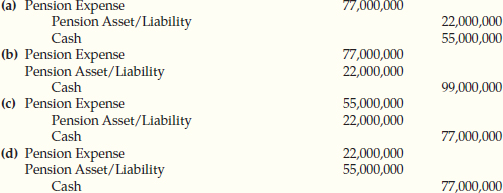
- At January 1, 2014, Wembley Company had plan assets of $250,000 and a defined benefit obligation of the same amount. During 2014, service cost was $27,500, the discount rate was 10%, actual return on plan assets was $25,000, contributions were $20,000, and benefits paid were $17,500. Based on this information, what would be the defined benefit obligation for Wembley Company at December 31, 2014?
(a) $277,500.
(b) $285,000.
(c) $27,500.
(d) $302,500.
- Towson Company has experienced tough competition for its talented workforce, leading it to enhance the pension benefits provided to employees. As a result, Towson amended its pension plan on January 1, 2014, and granted past service costs of $250,000. Current service cost for 2014 is $52,000. Interest expense is $18,000, and interest revenue is $5,000. Actual return on assets in 2014 is $3,000. What is Towson's pension expense for 2014?
(a) $65,000.
(b) $302,000.
(c) $317,000.
(d) $315,000.
IFRS CONCEPTS AND APPLICATION
IFRS20-1 What is net interest? Identify the elements of net interest and explain how they are computed.
IFRS20-2 What is service cost, and what is the basis of its measurement?
IFRS20-3 What is meant by “past service cost”? When is past service cost recognized as pension expense?
IFRS20-4 Bill Haley is learning about pension accounting. He is convinced that in years when companies record liability gains and losses, total comprehensive income will not be affected. Is Bill correct? Explain.
IFRS20-5 At the end of the current year, Joshua Co. has a defined benefit obligation of $335,000 and pension plan assets with a fair value of $345,000. The amount of the vested benefits for the plan is $225,000. Joshua has a liability gain of $8,300 (beginning accumulated OCI is zero). What amount and account(s) related to its pension plan will be reported on the company's statement of financial position?
IFRS20-6 Villa Company has experienced tough competition, leading it to seek concessions from its employees in the company's pension plan. In exchange for promises to avoid layoffs and wage cuts, the employees agreed to receive lower pension benefits in the future. As a result, Villa amended its pension plan on January 1, 2014, and recorded negative past service cost of $125,000. Current service cost for 2014 is $26,000. Interest expense is $9,000, and interest revenue is $2,500. Actual return on assets in 2012 is $1,500. Compute Villa's pension expense in 2014.
IFRS20-7 Tevez Company experienced an actuarial loss of $750 in its defined benefit plan in 2014. For 2014, Tevez's revenues are $125,000, and expenses (excluding pension expense of $14,000, which does not include the actuarial loss) are $85,000. Prepare Tevez's statement of comprehensive income for 2014.
IFRS20-8 The following defined pension data of Doreen Corp. apply to the year 2014.
Instructions
For 2014, prepare a pension worksheet for Doreen Corp. that shows the journal entry for pension expense and the year-end balances in the related pension accounts.
IFRS20-9 Buhl Corp. sponsors a defined benefit pension plan for its employees. On January 1, 2014, the following balances relate to this plan.
![]()
As a result of the operation of the plan during 2014, the following additional data are provided by the actuary.

Instructions
(a) Using the data above, compute pension expense for Buhl Corp. for the year 2014 by preparing a pension worksheet.
(b) Prepare the journal entry for pension expense for 2014.
IFRS20-10 Linda Berstler Company sponsors a defined benefit pension plan. The corporation's actuary provides the following information about the plan.

Instructions
(a) Compute the actual return on the plan assets in 2014.
(b) Compute the amount of other comprehensive income (G/L) as of December 31, 2014. (Assume the January 1, 2014, balance was zero.)
Professional Research
IFRS20-11 Jack Kelly Company has grown rapidly since its founding in 2004. To instill loyalty in its employees, Kelly is contemplating establishment of a defined benefit plan. Kelly knows that lenders and potential investors will pay close attention to the impact of the pension plan on the company's financial statements, particularly any gains or losses that develop in the plan. Kelly has asked you to conduct some research on the accounting for gains and losses in a defined benefit plan.
Access the IFRS authoritative literature at the IASB website (http://eifrs.iasb.org/). (Click on the IFRS tab and then register for free eIFRS access if necessary.) When you have accessed the documents, you can use the search tool in your Internet browser to respond to the following questions. (Provide paragraph citations.)
(a) Briefly describe how pension gains and losses are accounted for.
(b) Explain the rationale behind the accounting method described in part (a).
(c) What is the related pension asset or liability that may show up on the statement of financial position? When will each of these situations occur?
International Financial Reporting Problem
Marks and Spencer plc
IFRS20-12 The financial statements of Marks and Spencer plc (M&S) are available at the book's companion website or can be accessed at http://annualreport.marksandspencer.com/_assets/downloads/Marks-and-Spencer-Annual-report-and-financial-statements-2012.pdf.
Instructions
Refer to M&S's financial statements and the accompanying notes to answer the following questions.
(a) What kind of pension plan does M&S provide its employees?
(b) What was M&S's pension expense for 2012 and 2011?
(c) What is the impact of M&S's pension plans for 2012 on its financial statements?
(d) What information does M&S provide on the target allocation of its pension assets? How do the allocations relate to the expected returns on these assets?
ANSWERS TO IFRS SELF-TEST QUESTIONS
- c
- b
- a
- b
- d
Remember to check the book's companion website to find additional resources for this chapter.
1When used as a verb, fund means to pay to a funding agency (as to fund future pension benefits or to fund pension cost). Used as a noun, it refers to assets accumulated in the hands of a funding agency (trustee) for the purpose of meeting pension benefits when they become due.
2The FASB issued a separate standard covering the accounting and reporting for employee benefit plans.[1]
3Retirement assets in the 13 major global markets increased 4 percent to a record $27.5 trillion in 2011. The United States accounts for 59 percent of total pension assets, followed by Japan at 12 percent and the United Kingdom at 9 percent. Defined contribution assets for the seven largest markets—United States, United Kingdom, Japan, Netherlands, Canada, Australia, and Switzerland—now make up 43 percent of global retirement assets, up from 41 percent in 2005 and 38 percent in 2001. The United States, Australia, and Switzerland are the only countries with more defined contribution assets than defined benefit ones. See K. Olsen, “Global Pension Market Hits $27.5T,” http://www.pionline.com/article/20120206/PRINTSUB/302069986# (February 6, 2012).
4A recent federal law requires employees to explicitly opt out of an employer-sponsored defined contribution plan. This should help employees build their own nest eggs (as suggested in the opening story) and will contribute to further growth in defined contribution plans. However, note the following three warnings: (1) low-income workers will still not be able to stash enough away, (2) it leaves each participant alone to manage risk, and (3) companies establish a minimum contribution, which too many participants choose to use, instead of a larger contribution.
5An actuary's primary purpose is to ensure that the company has established an appropriate funding pattern to meet its pension obligations. This computation involves developing a set of assumptions and continued monitoring of these assumptions to ensure their realism. That the general public has little understanding of what an actuary does is illustrated by the following excerpt from the Wall Street Journal: “A polling organization once asked the general public what an actuary was, and received among its more coherent responses the opinion that it was a place where you put dead actors.”
6One measure of the pension obligation is to determine the amount that the Pension Benefit Guaranty Corporation would require the employer to pay if it defaulted. (This amount is limited to 30 percent of the employer's net worth.) The accounting profession rejected this approach for financial reporting because it is too hypothetical and ignores the going concern concept.
7When we use the term “present value of benefits” throughout this chapter, we really mean the actuarial present value of benefits. Actuarial present value is the amount payable adjusted to reflect the time value of money and the probability of payment (by means of decrements for events such as death, disability, withdrawals, or retirement) between the present date and the expected date of payment. For simplicity, though, we use the term “present value” instead of “actuarial present value” in our discussion.
8Recognize that GAAP applies to pensions as well as other postretirement benefit plans (OPEBs). Appendix 20A addresses the accounting for OPEBs.
9J. Ciesielski, “State of the Pension Promise: The S&P 500 in 2011,” The Analyst's Accounting Observer (May 29, 2012).
10At one time, companies applied the cash basis of accounting to pension plans by recognizing the amount paid in a particular accounting period as the pension expense for the period. The problem was that the amount paid or funded in a fiscal period depended on financial management and was too often discretionary. For example, funding could depend on the availability of cash, the level of earnings, or other factors unrelated to the requirements of the plan. Application of the cash basis made it possible to manipulate the amount of pension expense appearing in the income statement simply by varying the cash paid to the pension fund.
11At this point, we use the actual rate of return. Later, for purposes of computing pension expense, we use the expected rate of return.
12The use of a pension entry worksheet is recommended and illustrated by Paul B. W. Miller, “The New Pension Accounting (Part 2),” Journal of Accountancy (February 1987), pp. 86–94.
13Companies may use different ways of determining the calculated market-related value for different classes of assets. For example, an employer might use fair value for bonds and a five-year moving-average for equities. But companies should consistently apply the manner of determining market-related value from year to year for each asset class. Throughout our Zarle illustrations, we assume that market-related values based on a calculated value and the fair value of plan assets are equal. For homework purposes, use the fair value of plan assets as the measure for the market-related value.
14Recently, the FASB required more extensive disclosures related to pension plan assets. At a minimum, companies must disclose the amount of assets allocated to equities, government and corporate bonds, mortgage-backed securities, derivatives, and real estate. Also, information on concentrations of risk must be explained. Finally, fair value disclosures would be required, including classification of amounts into levels of the fair value hierarchy.[6]
15In 2006, Congress passed the Pension Protection Act. This law has many provisions. One important aspect of the act is that it forced many companies to expedite their contributions to their pension plans. One group estimates that companies in the S&P 500 would have had to contribute $47 billion to their pension plans if the new rules were fully phased in for 2006. That amount is about 57 percent more than the $30 billion that companies were expecting to contribute to their plans that year. Subsequently, Congress continues to provide pension funding relief. For example, in the “Moving Ahead for Progress in the 21st Century” Act (enacted July 6, 2012), companies can use a higher discount rate based on high-grade bond yields averaged over 25 years, which helps reduce the pension liability and required contributions.
16Pan American Airlines is a good illustration of how difficult it is to assess when to terminate. When Pan Am filed for bankruptcy in 1991, it had a pension liability of $900 million. From 1983 to 1991, the IRS gave it six waivers so it did not have to make contributions. When Pan Am terminated the plan, there was little net worth left upon which to impose a lien. An additional accounting problem relates to the manner of disclosing the possible termination of a plan. For example, should Pan Am have disclosed a contingent liability for its struggling plan? At present this issue is unresolved, and considerable judgment is needed to analyze a company with these contingent liabilities.
17A question exists as to whose money it is. Some argue that the excess funds belong to the employees, not the employer. In addition, given that the funds have been reverting to the employer, critics charge that cost-of-living increases and the possibility of other increased benefits are reduced because companies will be reluctant to use those remaining funds to pay for such increases.
18Another way that companies have reduced their pension obligations is through adoption of cash-balance plans. These are hybrid plans combining features of defined benefit and defined contribution plans. Although these plans permit employees to transfer their pension benefits when they change employers (like a defined contribution plan), they are controversial because the change to a cash-balance plan often reduces benefits to older workers.
The accounting for cash-balance plans is similar to that for defined benefit plans, because employers bear the investment risk in cash-balance plans. When an employer adopts a cash-balance plan, the measurement of the future benefit obligation to employees generally is lower, compared to a traditional defined benefit plan. See A. T. Arcady and F. Mellors, “Cash-Balance Conversions,” Journal of Accountancy (February 2000), pp. 22–28.
19Some companies have established pension poison pills as an anti-takeover measure. These plans require asset reversions from termination of a plan to benefit employees and retirees rather than the acquiring company. For a discussion of pension poison pills, see Eugene E. Comiskey and Charles W. Mulford, “Interpreting Pension Disclosures: A Guide for Lending Officers,” Commercial Lending Review (Winter 1993–94), Vol. 9, No. 1.
20Accounting Trends and Techniques recently reported that of its 500 surveyed companies, 317 reported benefit plans that provide postretirement healthcare benefits. In response to rising healthcare costs and higher premiums on healthcare insurance, companies are working to get their postretirement benefit costs under control.
21“OPEB” is the acronym frequently used to describe postretirement benefits other than pensions. This term came into being before the scope of guidance was narrowed from “other postemployment benefits” to “other postretirement benefits,” thereby excluding postemployment benefits related to severance pay or wage continuation to disabled, terminated, or laid-off employees.
22“Elements of Financial Statements,” Statement of Financial Accounting Concepts No. 6 (Stamford, Conn.: 1985), p. 13, footnote 21.
23Other postemployment (but before retirement) benefits include, but are not limited to, salary continuation, disability-related benefits, severance benefits, and continuance of healthcare benefits and life insurance for inactive or former (e.g., terminated, disabled, or deceased) employees or their beneficiaries. These benefits are accounted for similar to accounting for compensated absences (see Chapter 13).[10]
24D. Gerald Searfoss and Naomi Erickson, “The Big Unfunded Liability: Postretirement Health-Care Benefits,” Journal of Accountancy (November 1988), pp. 28–39.
25This is a benefit-years-of-service approach (the projected unit credit actuarial cost method). The FASB found no compelling reason to switch from the traditional pension accounting approach. It rejected the employee's full service period (i.e., to the estimated retirement date) because it was unable to identify any approach that would appropriately attribute benefits beyond the date when an employee attains full eligibility for those benefits. Employees attain full eligibility by meeting specified age, service, or age and service requirements of the plan.
26See James R. Wilbert and Kenneth E. Dakdduk, “The New FASB 106: How to Account for Postretirement Benefits,” Journal of Accountancy (August 1991), pp. 36–41.
27The FASB concluded that the discount rate for measuring the present value of the postretirement benefit obligation and the service cost component should be the same as that applied to pension measurements. It chose not to label it the settlement rate, in order to clarify that the objective of the discount rate is to measure the time value of money.
28IAS 32 states that a financial asset and a financial liability should be offset and the net amount reported in the statement of financial position when a company (a) has a legally enforceable right to set off the recognized amounts and (b) intends either to settle on a net basis, or to realize the asset and settle it simultaneously.
29As indicated earlier, service cost is comprised of current and past service cost. Determination of past service cost is based on the same actuarial valuation model as that used for current service cost. We discuss recognition of past service cost in a later section.
30The IASB indicates that if the beginning of the year amount changes materially (due to contributions to or payments out of the plan), an adjustment to the beginning balances should be made. For homework purposes, unless information indicates that balances have changed materially, use the beginning of the year balances.
31The IASB does not provide guidance on which of these two approaches is preferred. For homework purposes, report pension expense as a single total in income from operations in the statement of comprehensive income.
32The use of a pension entry worksheet is recommended and illustrated by Paul B. W. Miller, “The New Pension Accounting (Part 2),” Journal of Accountancy (February 1987), pp. 86–94.
33The IASB in IAS 19 limits the amount of a pension asset that is recognized, based on a recoverability test. This test, which has been further clarified in IFRIC 14, limits the amount of the pension asset to the sum of unrecognized actuarial gains and losses (discussed later) and amounts that will be received by the company in the form of refunds or reduction of future contributions. For purposes of homework, assume that a pension asset, if present, meets the criteria for full recognition.
34The IASB also indicates that gains and losses on non-routine settlements are considered past service costs. A settlement is a payment of benefits that is not set out in the terms of the plan.
35The IASB is silent as to whether the account “Accumulated Other Comprehensive Income” should be used instead of another equity account, like Retained Earnings. For homework purposes, use an Accumulated Other Comprehensive Income account. The IASB also permits the transfer of the balance in the Accumulated Other Comprehensive Income account to other equity accounts at a later date.



